3 weeks, 1 rental car, and a trip across the country. Morocco completely surprised us with its chaotic cities, endless deserts, photogenic riads, green oases, traditional kasbahs, and superb hospitality. In this post, we’ll show you our exact route through Morocco, our favorite stops, and tips for your own Morocco tour.
Start & End: Marrakech
️ Travel time: May 2025
Transport: Rental car from/to Marrakech
⏰ Duration: 19 days
Total distance: approx. 3,100 km
Costs: approx. €2,000 per person (for 2 travelers)
- Morocco tour – Our 19-day route
- Who is this Morocco tour suitable for?
- What awaits you in Morocco:
- Day 1: Arrival in Morocco & Accommodation
- Day 2: Exploring Marrakech
- Day 3: Drive to Fez
- Day 4: Exploring Fez
- Day 5: Off-the-beaten-track Fez
- Day 6: The blue city of Chefchaouen
- Day 7: The modern capital of Rabat
- Day 8: Rabat outside the Medina
- Day 9: Marrakech highlights in the south
- Day 10: Marrakech highlights in the north
- Day 11: Traveling outside of Marrakech
- Day 12: Across the High Atlas to Ait Ben Haddou
- Day 13: Kasbahs Road
- Day 14: Todra Gorge and Merzouga
- Day 15: Merzouga and Drâa Valley
- Day 16: Drive to Taghazout & Beach Hotel
- Day 17: Exploring Taghazout
- Day 18: Port City of Essaouira
- Day 19: Last Walk & Return Flight
- Our Best Travel Tips for Morocco
Morocco Tour – Our 19-Day Route
Our Morocco tour started and ended in Marrakech – we traveled the entire time in a rental car. After the first few days in chaotic yet beautiful Marrakech, we headed north to the royal city of Fez.
Here, a winding old town and the famous tanneries awaited us. After three intense days, we continued on to the blue mountain village of Chefchaouen and then to the modern coastal town of Rabat with its surprisingly relaxed vibe. We spent a few more days back in Marrakech before the second half of the trip began. From there, the landscape became considerably more varied. We crossed the High Atlas to Ait Ben Haddou with its famous mud fortress, then continued through the Dadès Valley to Tinghir and the impressive Todra Gorge. In Merzouga, we suddenly found ourselves in the middle of the desert. Afterwards, the route led us through the green Drâa Valley back toward the Atlantic. In Taghazout, we took in the relaxed surfer vibes and enjoyed the sea air in Essaouira. Finally, we headed back to the airport in Marrakech.
Morocco Road Trip & Itinerary (19 days)
Our overnight locations in Morocco:
- Marrakech (2 nights)
- Fez (3 nights)
- Chefchaouen (1 night)
- Rabat (1 night)
- Marrakech (4 nights)
- Ait Ben Haddou (1 night)
- Tinghir (1 night)
- Merzouga (1 night)
- Drâa Valley (1 night)
- Taghazout (2 nights)
- Essaouira (1 night)
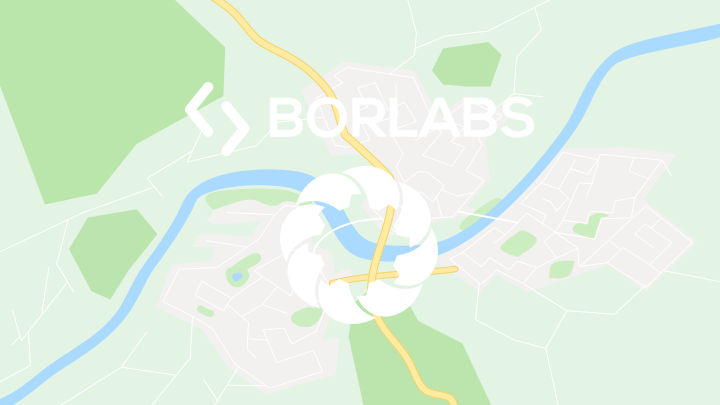
By loading the map, you accept Google’s privacy policy.
Learn more
Load map
Tip: If you have less time, we would rather skip the cities in the north, for example Fez, Meknes or Rabat. Our route was heavily landscape-oriented, with a focus on nature, the desert and smaller towns.
Depending on whether you want to experience cities or nature, you can adapt your route accordingly. If you fancy the imperial cities, you should combine Marrakech with Fez and/or Rabat. However, if you prefer to be outdoors, you should concentrate on the mountains, the desert and the coast.
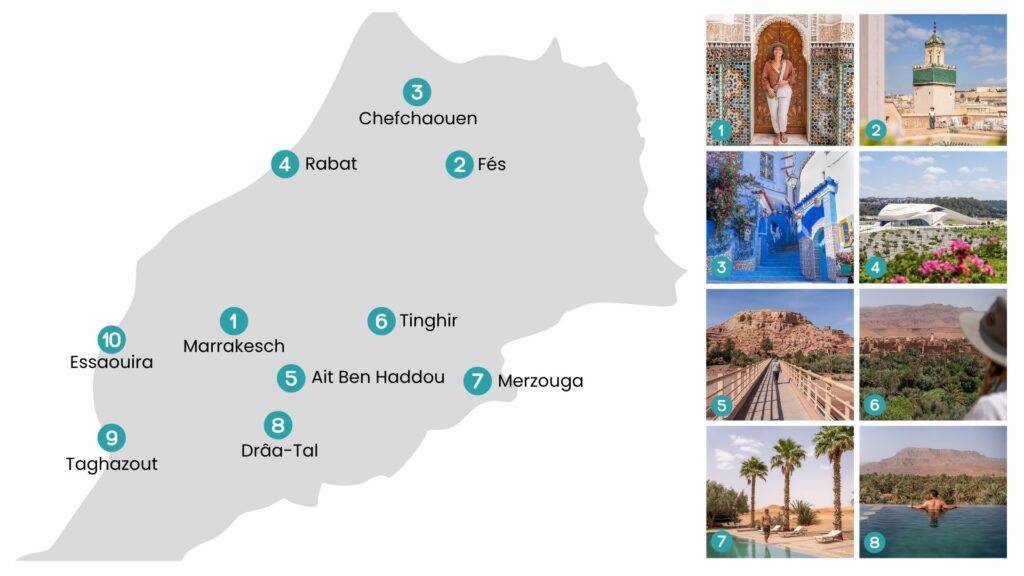
Who is this Morocco round trip suitable for?
If you’re looking for variety and want to experience Morocco in all its diversity, this route is just right for you. It combines chaotic cities, vast deserts, green oases, mountains, and the coast. The mix of culture, nature, and a bit of adventure is perfect if you’re open to new experiences and can stay spontaneous.
This route is particularly suitable for those who enjoy traveling with a rental car and aren’t afraid of longer distances. If you want to plan your accommodations and stops flexibly yourself, this is the right place. Even those who don’t need action every day and don’t mind driving for four to six hours at a time will enjoy this trip.
The route is less suitable for those who prefer to cover short distances, don’t like driving, or prefer to spend their entire stay in a city. Those primarily looking for a beach holiday with plenty of comfort are better off in Agadir or Taghazout.
What awaits you in Morocco:
- Incredible landscape diversity (mountains, desert, sea, oases…)
- Great adventures (road trip, sandboarding, hiking, desert camping, quad tour…)
- Plenty of culture & History (imperial cities, medinas, riads …)
- Interesting cuisine (spicy tagines, fresh mint tea, lots of bread)
- Hospitality (warm, curious and open)
- Destination for individualists (plan your own trip and travel flexibly)
- Relatively safe country to travel to (also possible alone and as a woman with a little preparation)
Day 1: Arrival in Morocco & Accommodation
- Daily distance: 2,895.94 km as the crow flies from Berlin to Marrakech
- Flight time: approx. 4 hours with Ryanair
- Accommodation: Riad Dar El Qadi*
- Highlights: Beautiful riad with a great roof terrace
- Recommendation: Guided tour through the souks of the Medina*
We landed in Marrakech in the middle of the night, around 12:30 a.m. Immigration was surprisingly quick and uncomplicated. Luckily, we had booked the transfer in advance through our riad, and our driver was already waiting at the exit. We walked through the quiet streets directly into the Medina to our first accommodation.
Despite the late hour, we received a warm welcome. There was hot mint tea and some initial information from the host. Around 2:30, we finally fell into bed, tired but excited about everything that awaited us in the next few weeks.
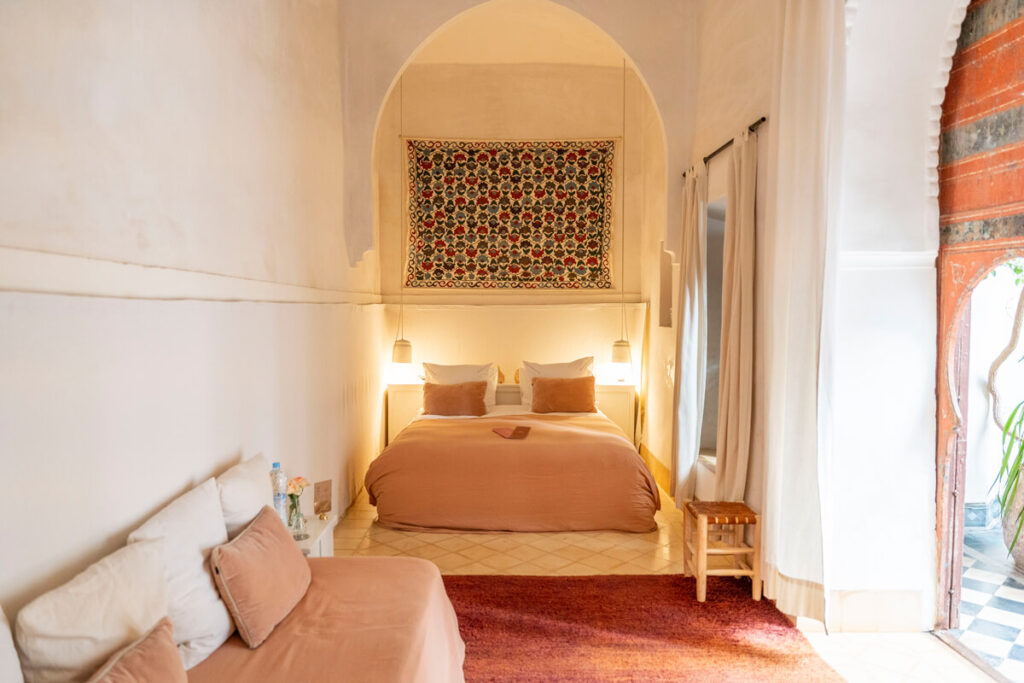
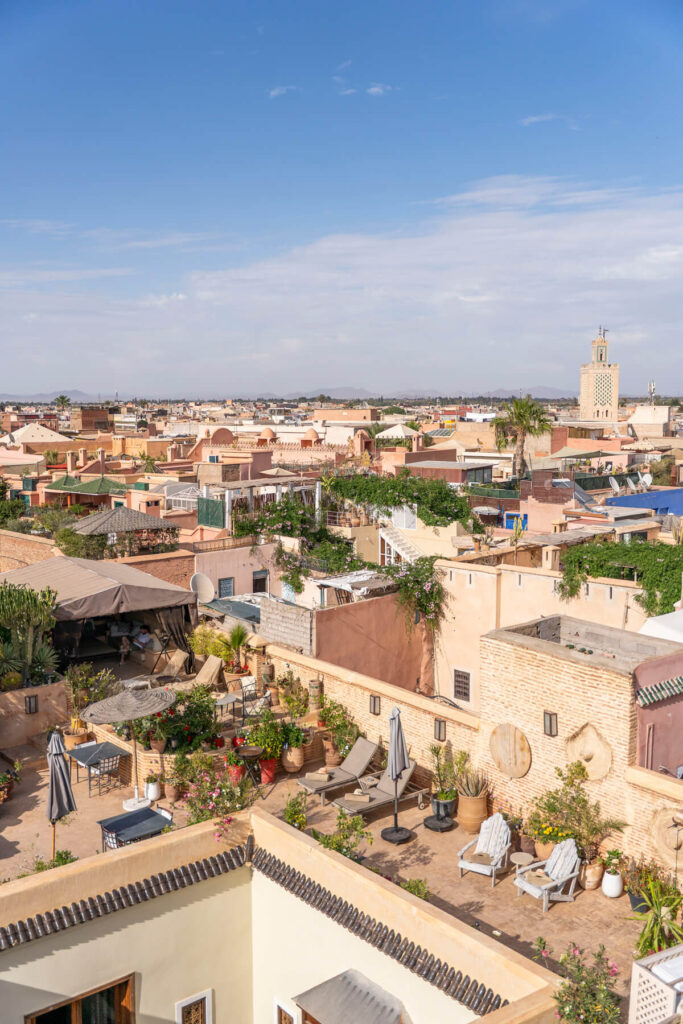
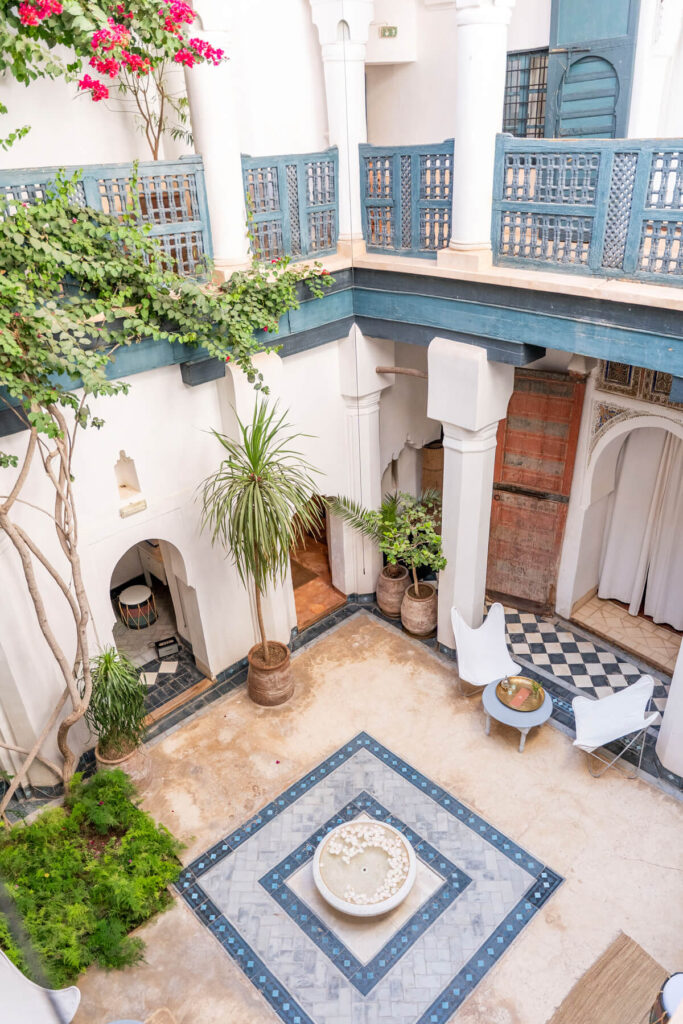
Day 2: Exploring Marrakech
- Daily distance: 20,000 steps
- Accommodation: Riad Dar El Qadi*
- Highlights: Souks, Ben Youssef Koran School
- Activities: Ben Youssef, Secret Garden & Souk Tour*
After our late arrival, we slept in. Then we had breakfast on the roof terrace of our riad in bright sunshine. With a view over the rooftops of the medina, freshly squeezed orange juice, and Moroccan bread with amlou, you could definitely start the day worse.
Afterward, we set off in a relaxed manner, without a plan and without stress. We knew we would be spending another four days in Marrakech. So we simply went with the flow and strolled through the narrow alleys of the souks, past mopeds, donkey carts, mountains of spices, colorful fabrics, and countless vendors hawking their wares.
Our first impression of the typical Marrakech madness was loud, colorful, chaotic, and full of life. Just as we experienced it eight years ago on our first tour. A small highlight of the day was a visit to the Ben Youssef Koranic School. A real gem in the heart of the medina. The courtyard, with all its details, is particularly impressive.
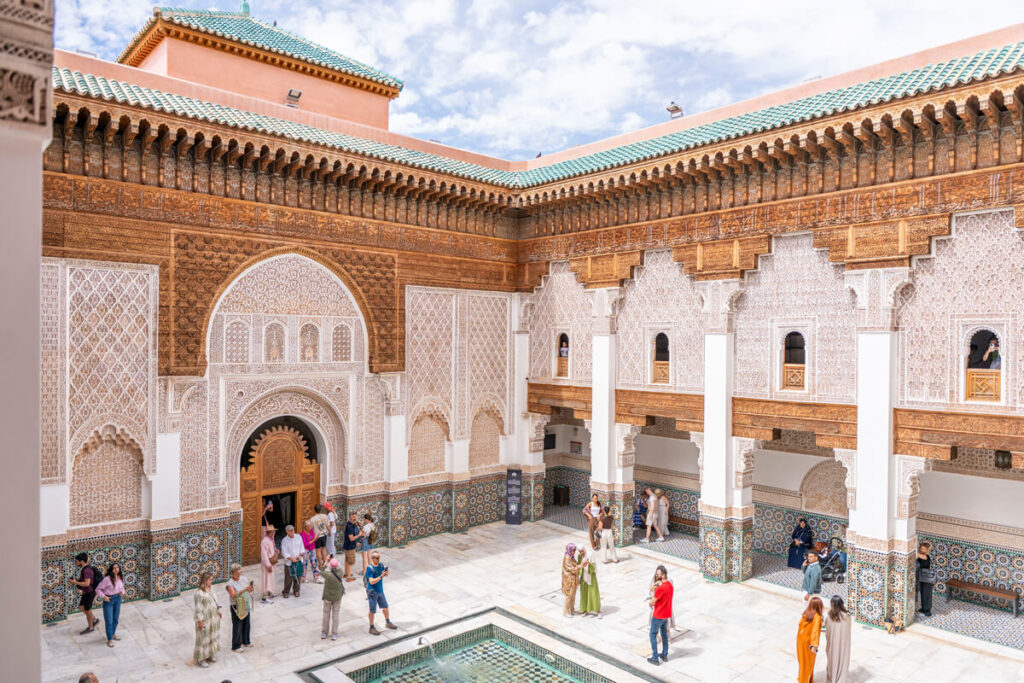
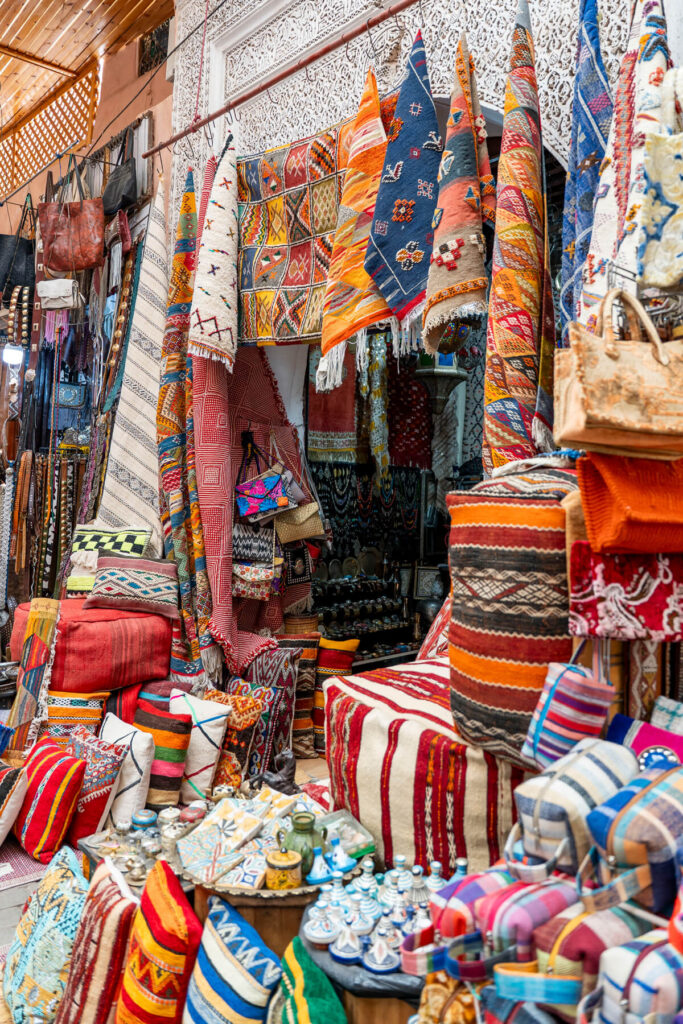

Day 3: Drive to Fez
- Daily distance: 540 km (via toll roads)
- Accommodation: Riad Dar Skalli & Spa*
- Highlights: Exploring the riad, first steps through the historic medina
- Activities: Guided walking tour through the medina of Fez*
The route to Fez is mostly on the highway and is a relaxing drive. There is hardly any traffic, except around Casablanca and Rabat, and the roads are in very good condition. The drive is quite long, however. It took us around seven hours, including a longer lunch break along the way.
The toll totaled 175 dirhams, or about 16 euros. Payment is made at small stations directly on the highway, usually in cash, but sometimes with a card. You can also choose a route without toll roads, but it will take almost two hours longer.
After arriving in Fez, we checked into our historic riad for the night and strolled a bit through the medina. Gathering our first impressions, getting a little orientation. In the evening, we had a relaxed dinner before we fell into bed, pretty exhausted.
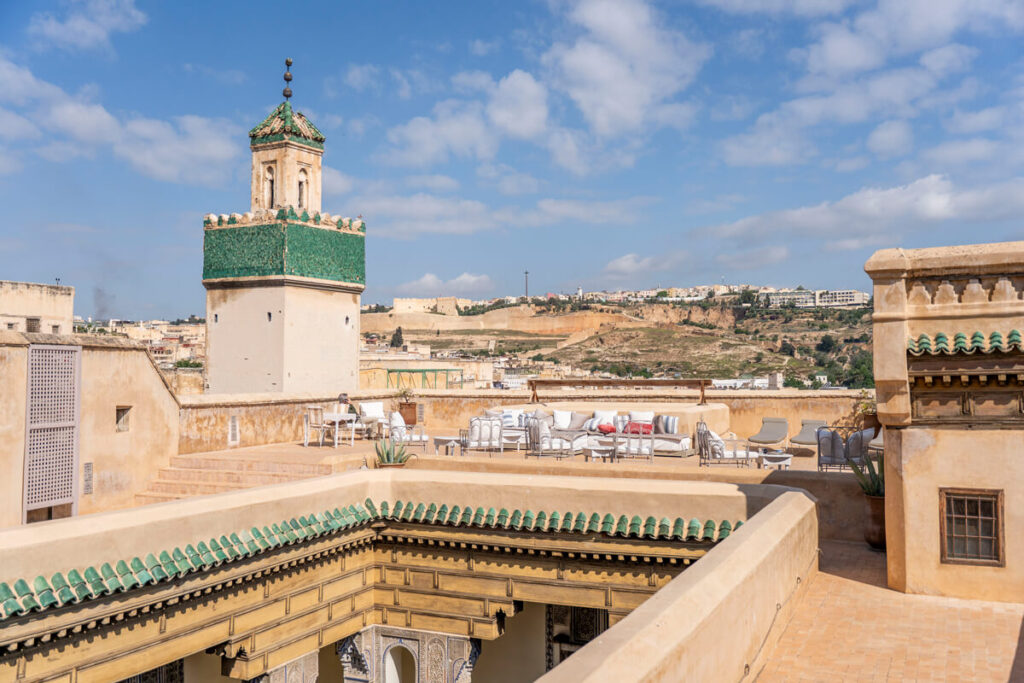
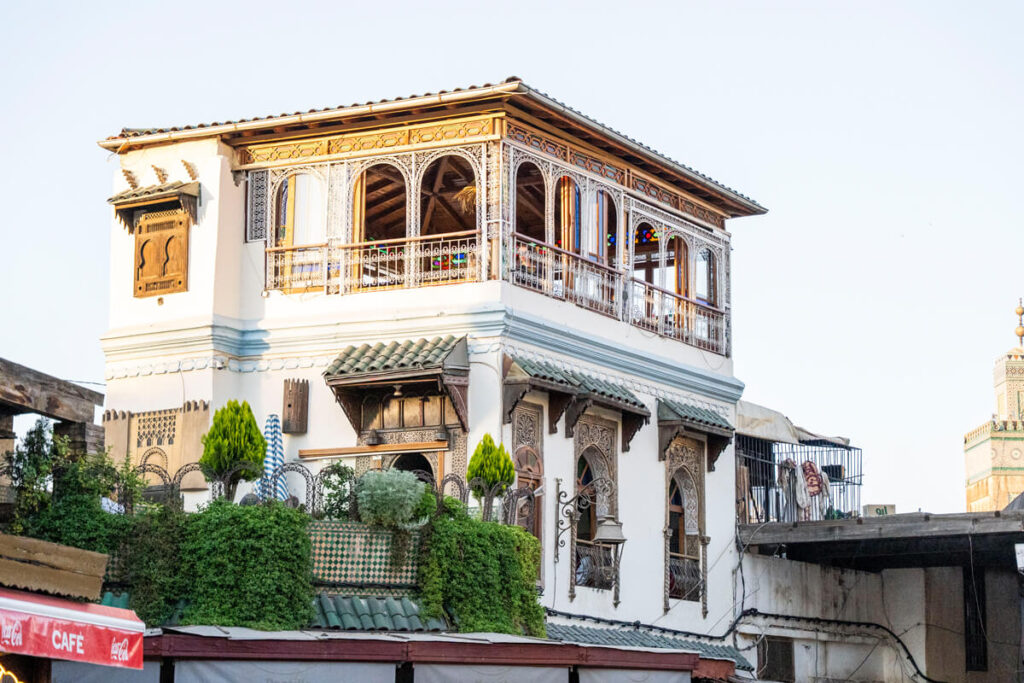
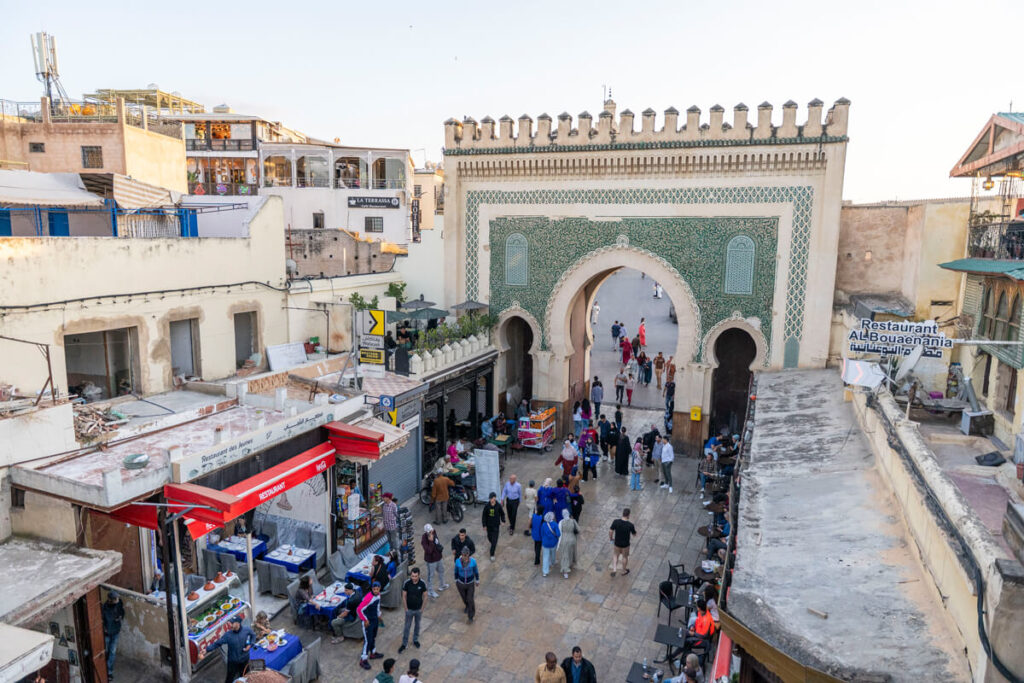
Day 4: Exploring Fez
- Daily distance: 20,000 shrits
- Accommodation: Hotel & Spa Dar Bensouda*
- Highlights: Moved into the new riad, guided tour of the medina
- Activities: Guided tour of the medina of Fez*
After a hearty breakfast in our riad, we start our second day in Fez with a guided city tour. Since we had never been to Fez before, we wanted to get a feel for the city with a local.
We had booked the tour online in advance, and it led us through the narrow streets, past mosques, madrasas, small workshops, and, of course, to the famous tanneries. Our guide not only showed us the most important sights but also shared a lot of fascinating background information about the history and everyday life in Fez.
After the tour, we spent some time exploring the medina on our own and visited a few highlights. Among other places, we visited the beautiful Bab Boujloud gate, the Al-Qarawiyyin Mosque (from the outside), and the old city walls.

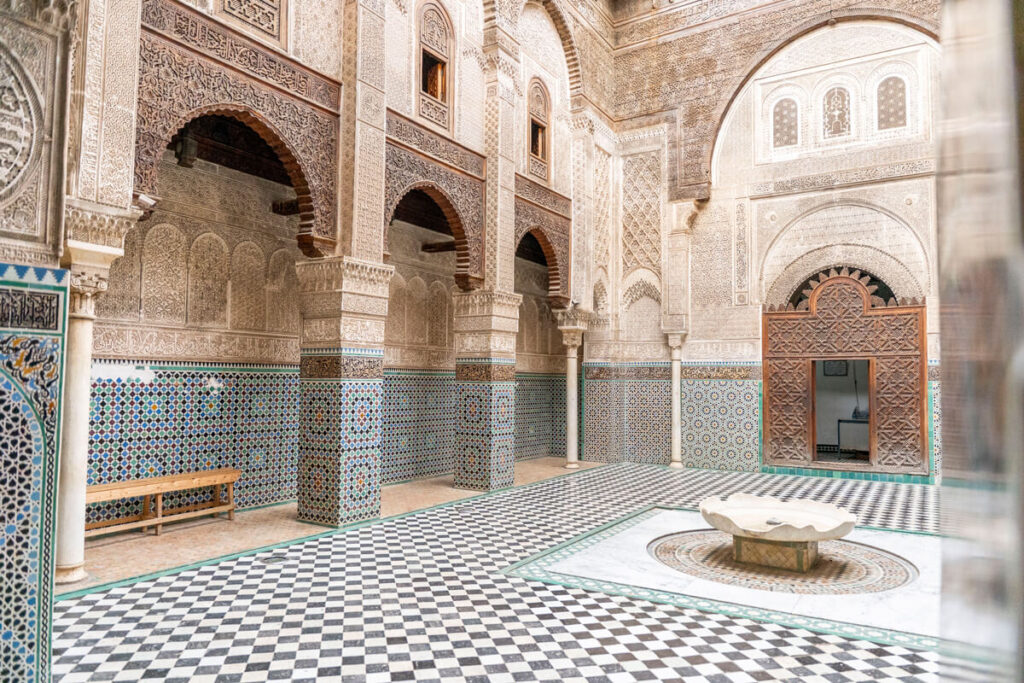
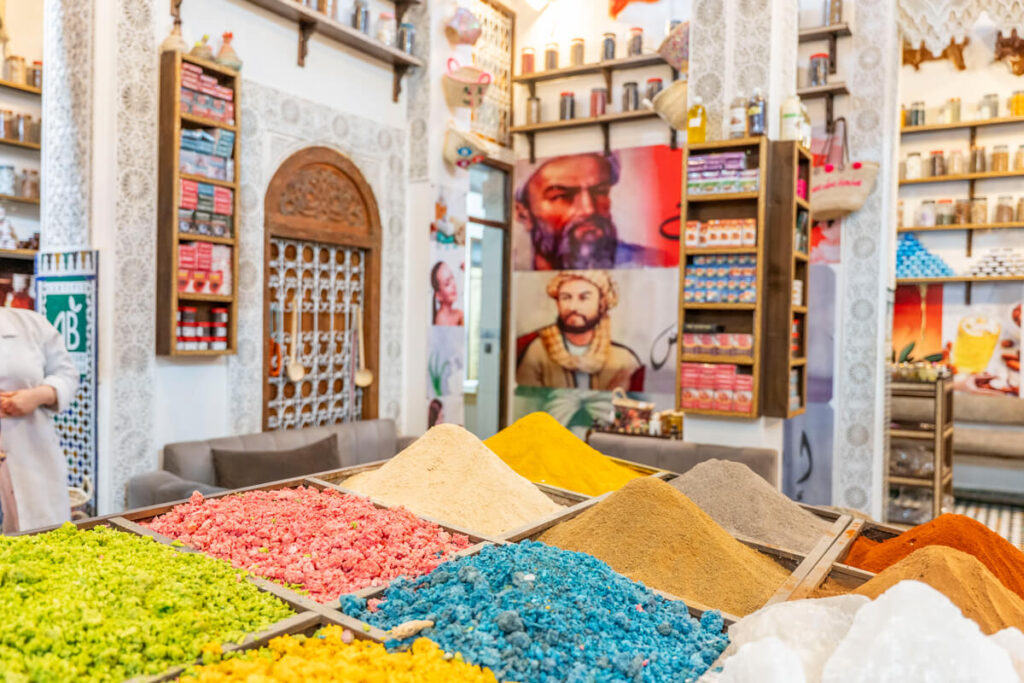
Day 5: Fez off the beaten track
- Daily distance: 20,000 steps
- Accommodation: Hotel & Spa Dar Bensouda*
- Highlights: King’s Palace (from the outside), Jewish Quarter, City Park
- Activities: Souk tour and traditional cooking class*
After a really good breakfast in the beautiful Riad Bensouda, we set off again. On this day, we deliberately ventured a bit away from the hustle and bustle and got to know a quieter side of Fez.
We visited the King’s Palace. The enormous golden gates can only be viewed from the outside, but they are still quite impressive. Afterwards, we continued on to the Jewish quarter of Mellah, which, with its wider streets and quieter atmosphere, feels completely different from the Medina.
We took a break in the Jnan Sbil city park. Plenty of greenery, shady paths, and a true oasis of peace in the middle of the city. Unfortunately, there was a lot of trash lying around in the park at the time, which we found very unfortunate. We spent the early evening on the roof terrace of our riad and enjoyed the sunset.
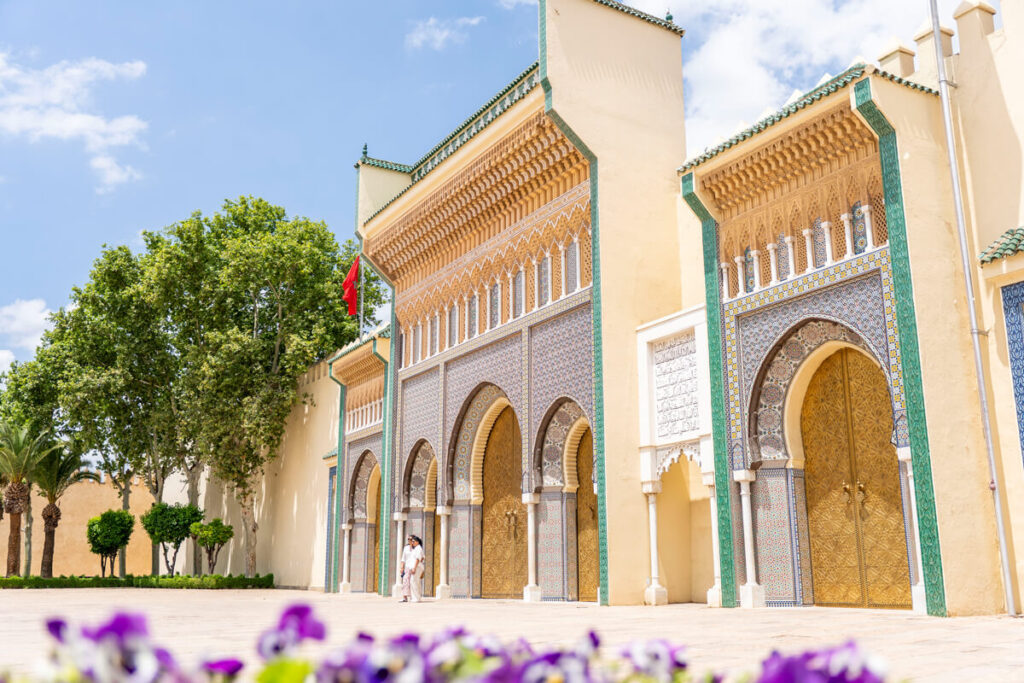
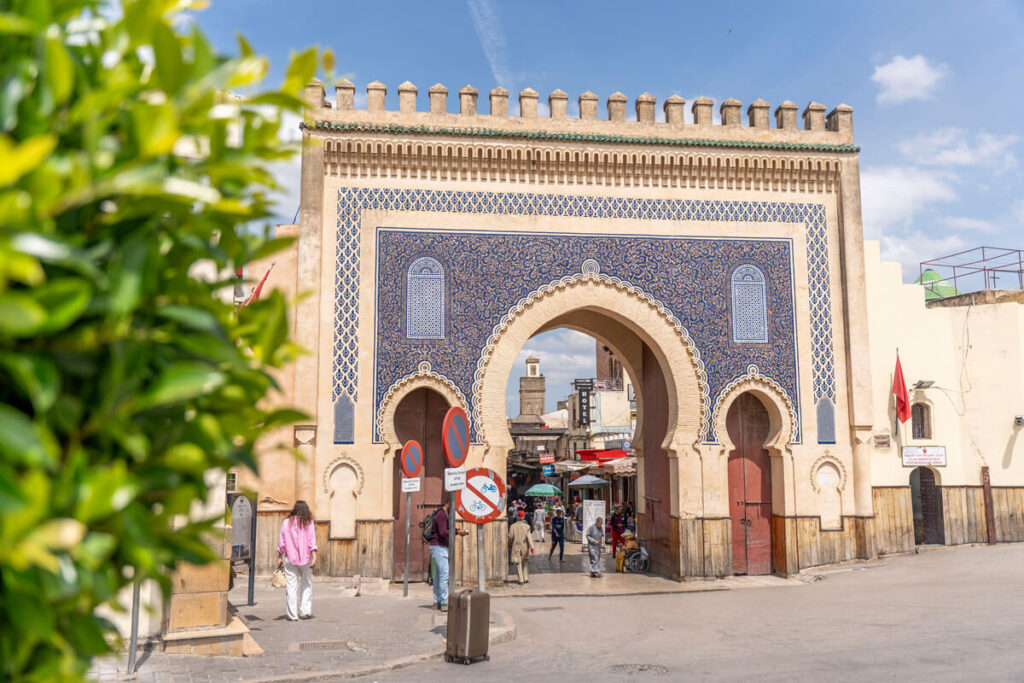
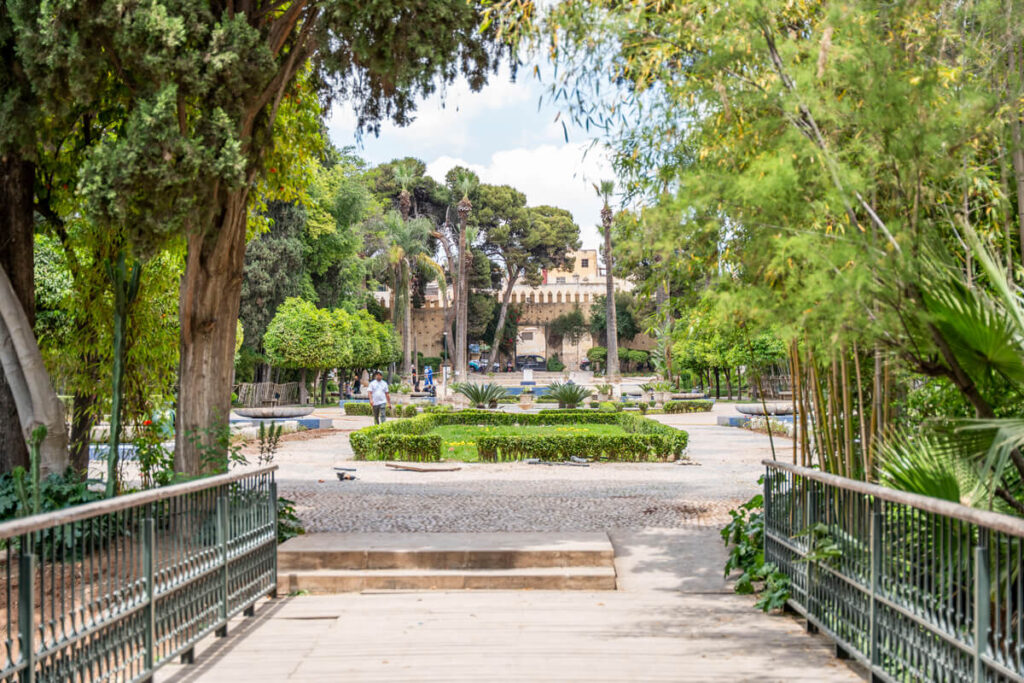
Day 6: The Blue City of Chefchaouen
- Daily distance: 212 kilometers
- Accommodation: Riad Lella Chama*
- Highlights: City streets, Kasbah, Plaza Uta el Hamman
- Activities: Chefchaouen: Hidden Gems Guided Tour with Mint Tea*
On the sixth day of our tour, we continued to Chefchaouen, the famous blue city in the Rif Mountains. The drive from Fez took about four hours and led through hilly landscapes and small villages. The roads were in very good condition.
Once we arrived in Chefchaouen, we first moved into our small riad in the middle of the medina and took a short breather. After that, we immediately set out to explore the old town. And yes, Chefchaouen really is as photogenic as everyone says. Blue walls, colorful doors, narrow alleys, cats on steps. A new subject awaits around every corner.
We found the town absolutely charming. Despite its fame, it was surprisingly relaxed; the alleys were well-spaced, and it was never really crowded. The Kasbah in the center was particularly beautiful. From the top, you have a fantastic view of the town and the surrounding mountains.
Directly in front of it is Plaza Uta el Hamman, the central square with many cafés and restaurants. A perfect place for a short break, a cup of tea, and to watch the hustle and bustle. We were pleasantly surprised by the city and didn’t regret the detour to the far north.
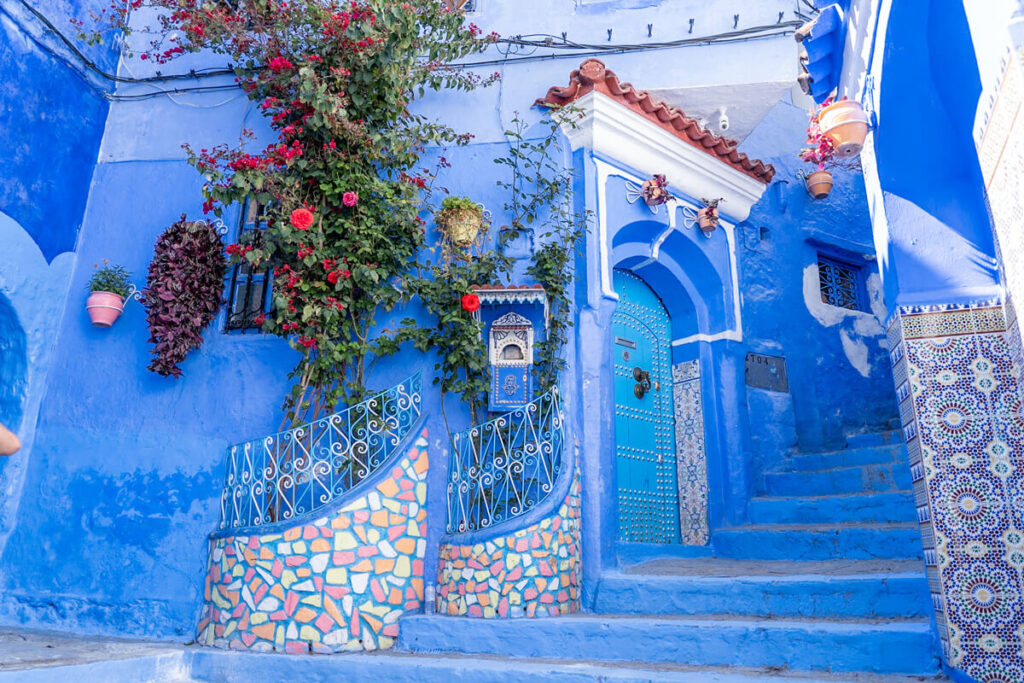
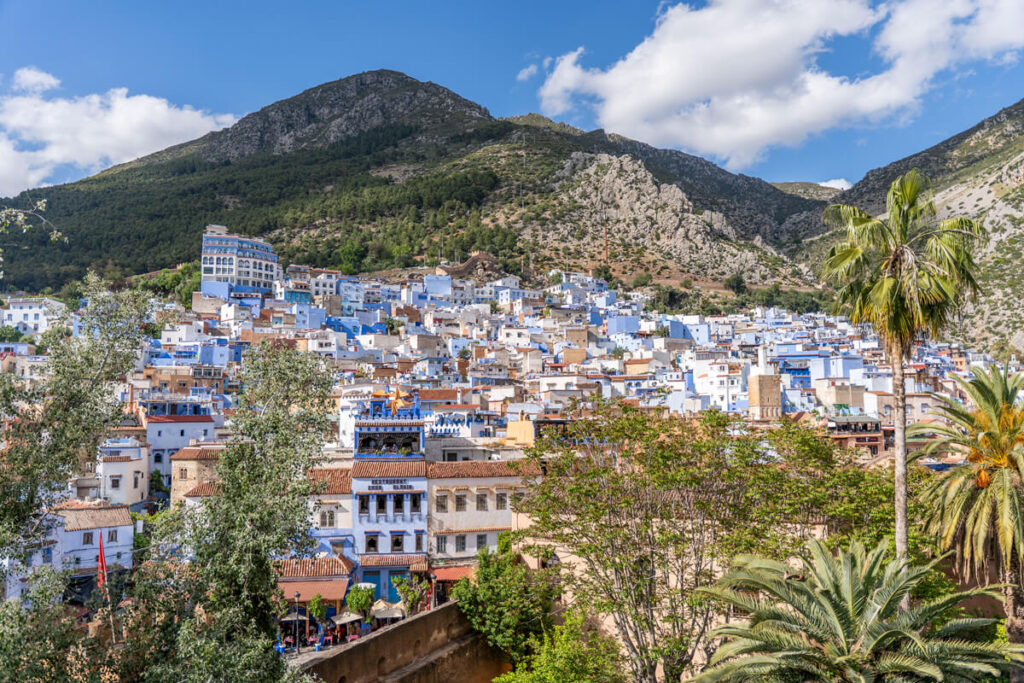

Day 7: The Modern Capital Rabat
- Daily Distance: 250 kilometers
- Accommodation: Riad Amaris*
- Highlights: Medina, Kasbah of the Oudaias, Andalusian Garden, Sea View
- Activities: Guided City Tour with Visit to the Mausoleum of Mohammed V*
From the blue city of Chefchaouen, we continued on to the modern capital Rabat. The vibe here is completely different. There are fewer tourists, wide streets, modern neighborhoods, and at the same time a beautiful old town right by the sea. The medina feels less oriental than in other cities, which is due to the fact that it was built much later.
A real highlight for us was the Kasbah of the Oudaias. The white and blue fortress overlooking the sea is quiet, charming, and offers many photo opportunities. Right at the entrance is the Andalusian Garden, a small green oasis with palm and orange trees.
Behind the kasbah runs a promenade along the Atlantic. Ideal for a stroll or a sundowner overlooking the waves. Rabat may not be as exciting as Marrakech or Fez, but that’s exactly what we found so pleasant. Perfect for a relaxing stopover with sea air and capital city flair.
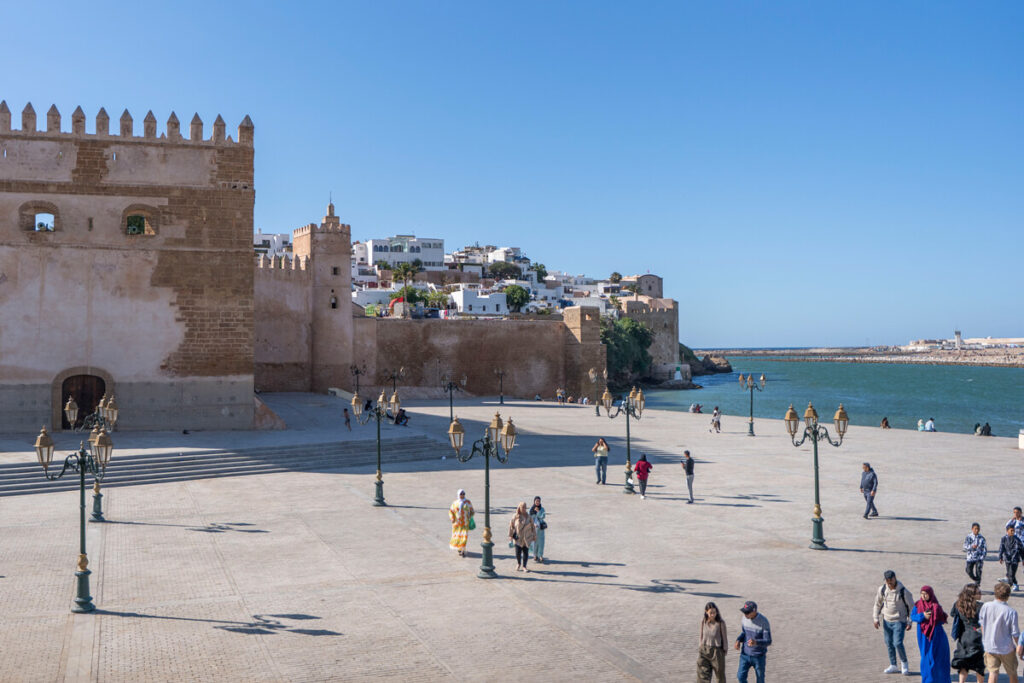

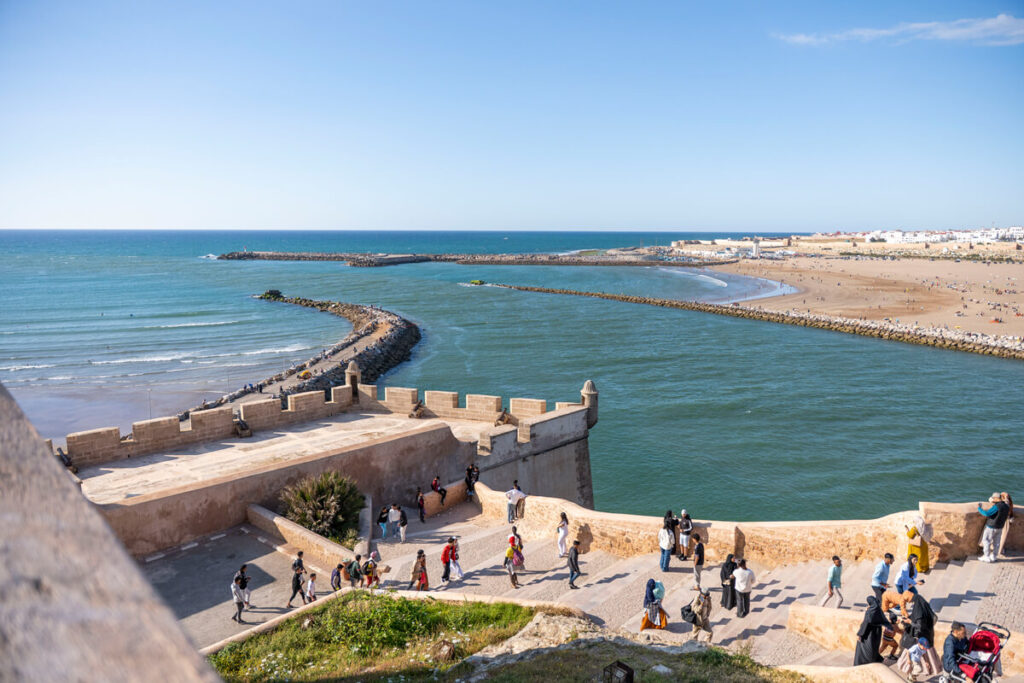
Day 8: Rabat outside the Medina
- Daily distance: 326 kilometers
- Accommodation: Riad Amaris* & Riad Chocolat* in Marrakech
- Highlights: Mausoleum of Mohammed V, National Theater, Hassan Tower
- Activities: Cooking class in Rabat in a family home*
The next morning we took a few more classics with us. We visited the impressive mausoleum of Mohammed V, enjoyed the view of the modern National Theater, and marveled at the 250-meter-high Hassan Tower from a distance, which somehow seems totally futuristic.
We took the modern tram back to the Medina, had a quick espresso stop, and then hopped in the car. In the early afternoon, we set off for Marrakech in our rental car. The almost four-hour drive was relaxing, but the last few meters through the city center were quite the challenge.
The traffic in Marrakech is simply wild. We really wouldn’t recommend driving through the city by car to anyone. Narrow streets, mopeds on all sides, hardly any rules – it’s just nerve-wracking. After checking into our riad, we just popped around the corner for a snack in the evening. There was nothing more to do that day.
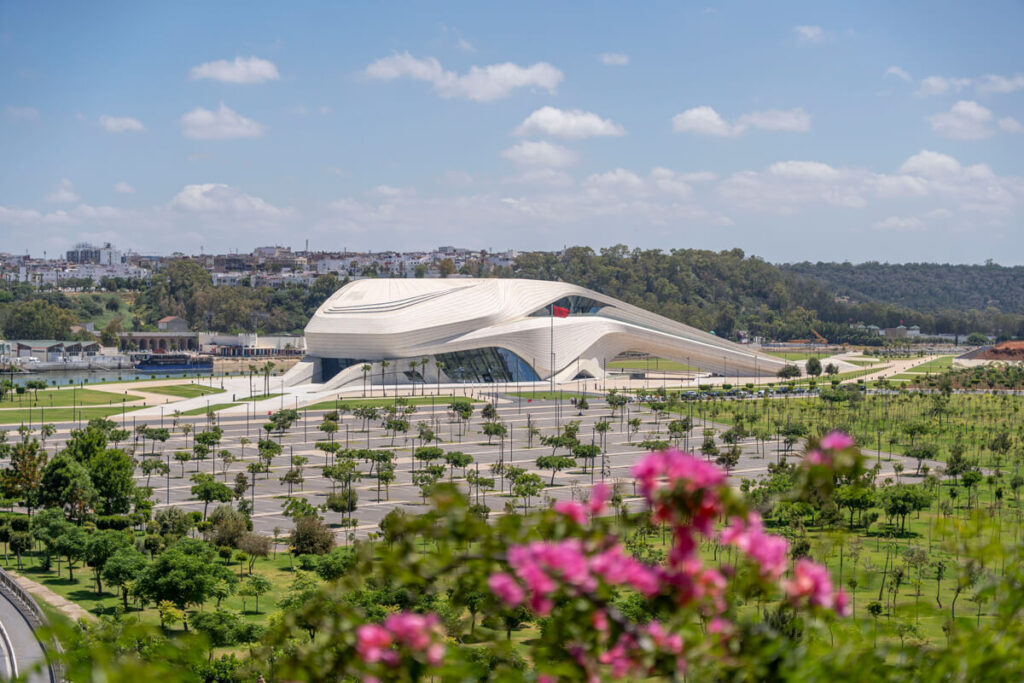

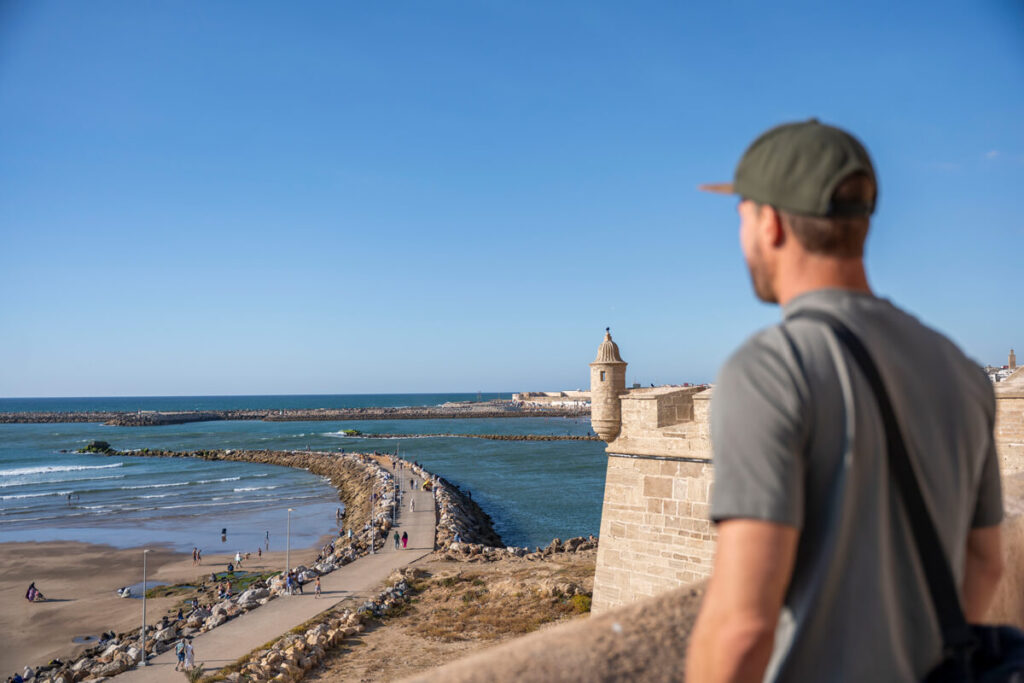
Day 9: Marrakech Highlights in the South
- Daily stage: 20,000 steps
- Accommodation: Riad Chocolat*
- Highlights: Bahia Palace, El Badi Palace, Moroccan Culinary Arts Museum
- Activities: Bahia Palace, Saadian Tombs, Souk and Medina Tour*
Today, some of the most famous sights in the south of the Medina were on the agenda. We visited the Bahia Palace. Architecturally truly impressive, but unfortunately completely overcrowded and quite packed. We couldn’t really enjoy it. A security guard advised us to arrive after 5 p.m., when it’s much quieter.
Right next door, however, we discovered a real surprise: the Moroccan Culinary Arts Museum. Admission is free, there’s a beautiful courtyard, plenty of peace and quiet, and an interesting exhibition on Moroccan culinary culture. For us, it was a really nice alternative to the Bahia Palace.
Also very close by are the El Badi Palace with its massive ruins and the Saadian Tombs. Both are easily accessible on foot and are worth a visit, especially if you arrive in the morning before the larger tourist groups arrive.
‼️ Important to know: Construction work is currently taking place at the El Badi Palace; many areas are under scaffolding. The same applies to the Bahia Palace. Despite the construction work, you still have to pay full admission to both attractions.
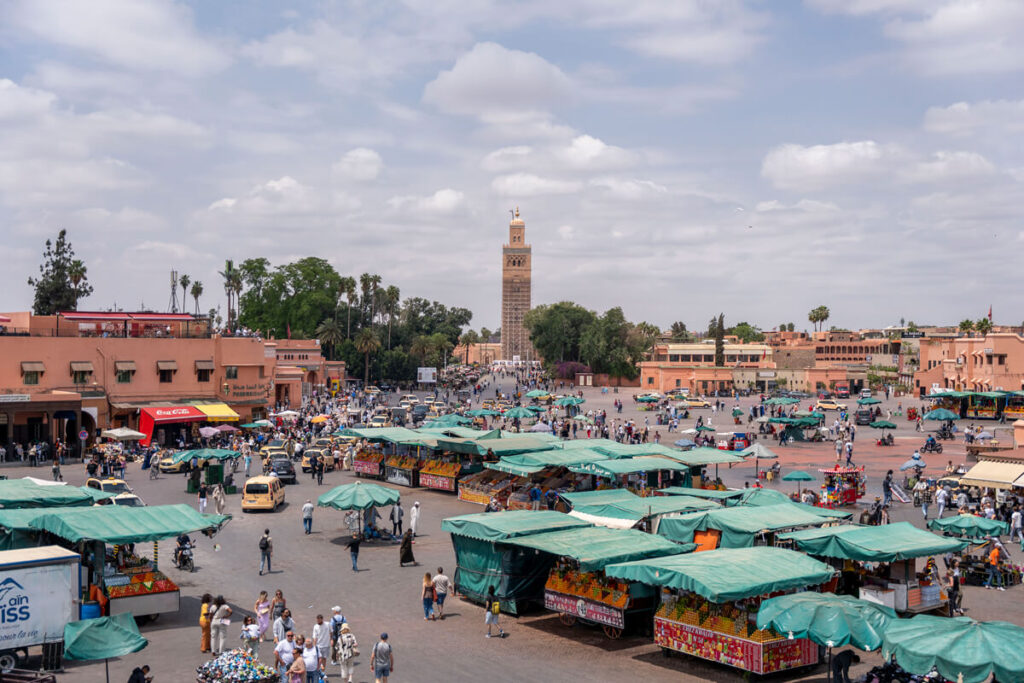
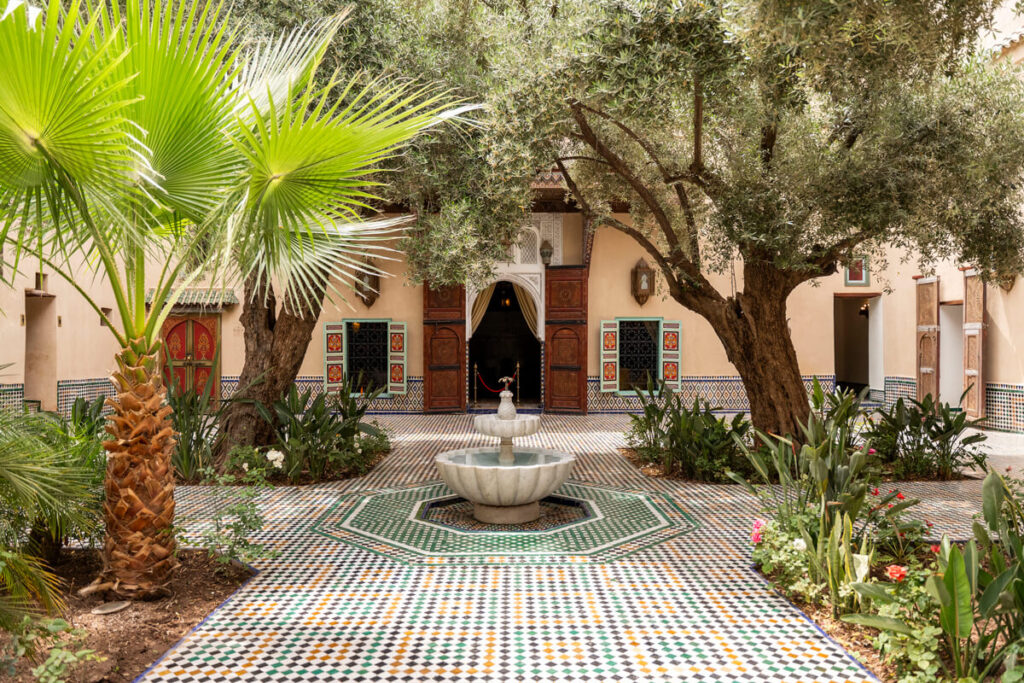

Day 10: Marrakech Highlights in the North
- Daily Distance: 20,000 Steps
- Accommodation: Riad Instant T*
- Highlights: El Bacha Museum, Jardin Majorelle, Cooking Class
- Activities: Book our cooking class in Marrakech* here
On the tenth day of our Morocco tour, we moved into a new riad. It was located in the north of the medina and was the perfect starting point for us to explore the northern part of the city.
In the morning, we strolled through the quieter alleys of the northern medina. Less touristy, but really exciting to explore. We had lunch at the Pikala Café. The food was delicious and the atmosphere was totally relaxed.
In the afternoon, we went to the El Bacha Museum. We didn’t get there until late afternoon, which was absolutely worth it. Hardly any visitors, a lovely atmosphere, a great courtyard, and an interesting exhibition.
Next up was the Jardin Majorelle. Our tip here too: go late in the evening, just before closing. It’s much emptier then. You have to book tickets online in advance!
To round off the day, we took part in a cooking class with market shopping*. We shopped, chopped, cooked, laughed, and of course, ate together. The group was really cool, and the food was incredibly delicious. We highly recommend it!
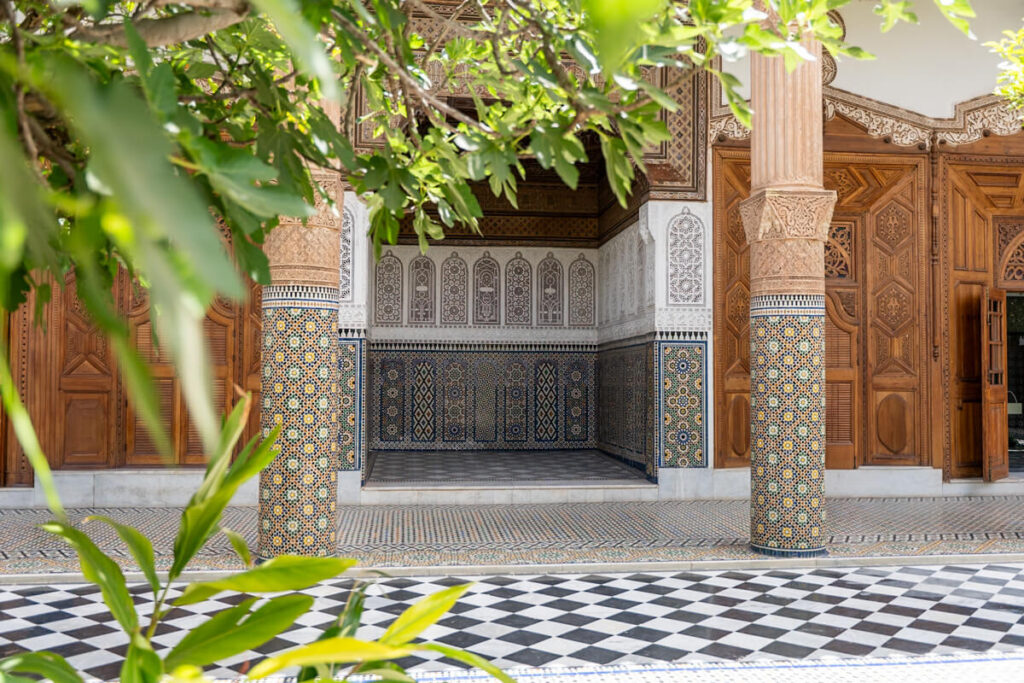
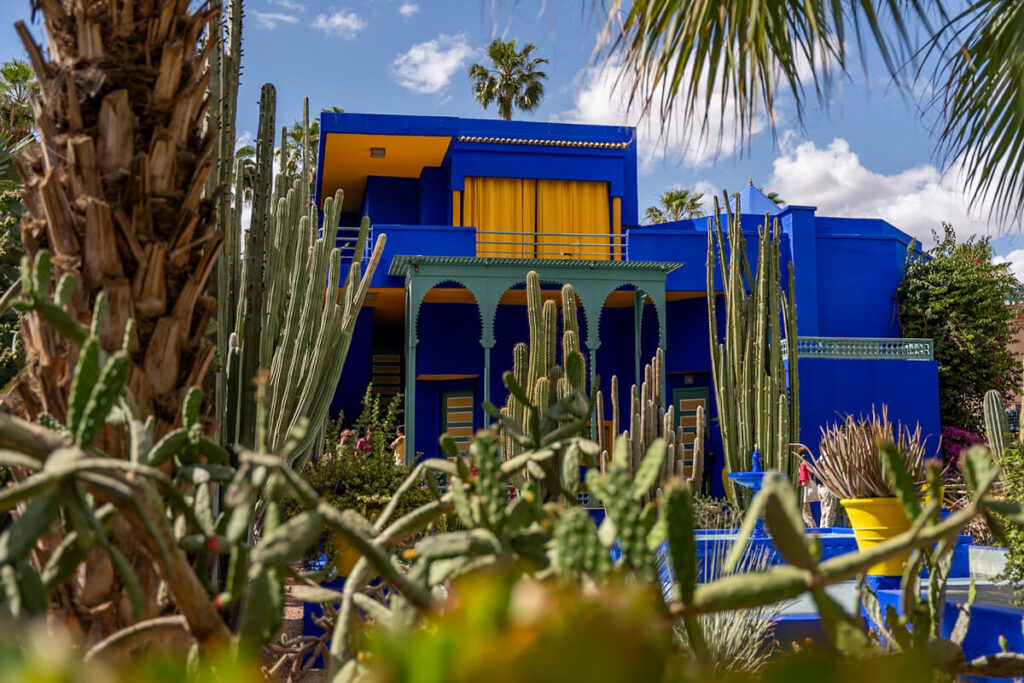
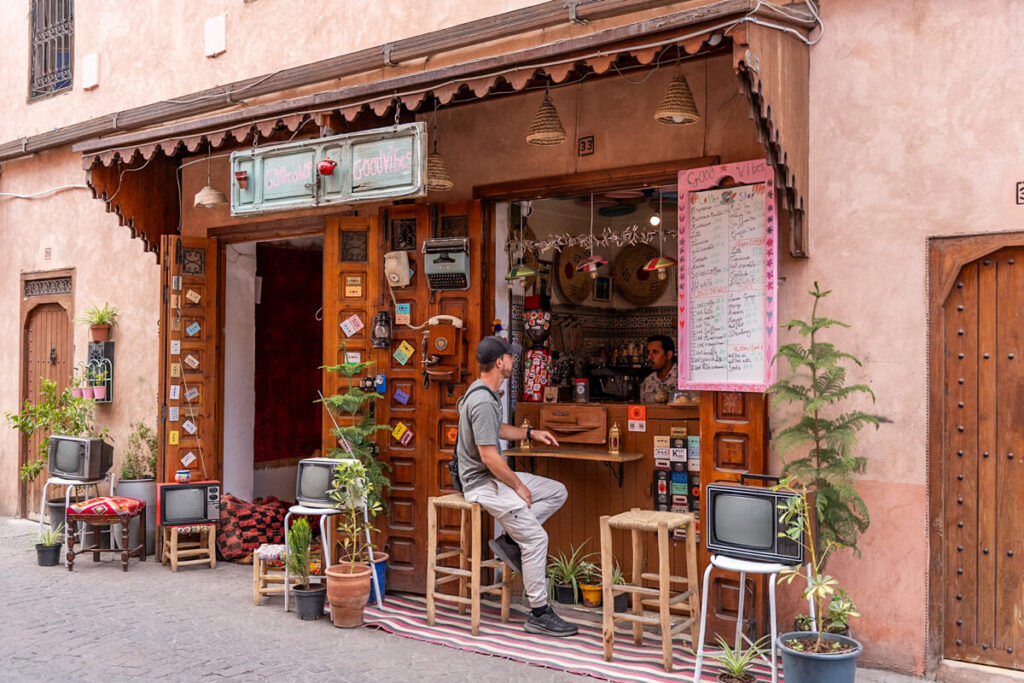
Day 11: Traveling outside of Marrakech
- Daily distance: 165 kilometers
- Accommodation: Riad Instant T*
- Highlights: Agafay Desert, Anima Garden, Waky Marrakech, Ourika Valley
- Activities: Quad tour*, Anima Garden ticket*, Atlas Mountains, Ourika Valley & Waterfall*
After the hustle and bustle of the city, we wanted to get out and explore the area around Marrakech. We started with a quad tour through the Agafay Desert*. No sand dunes, but dusty tracks, vast rocky landscapes, the imposing Atlas Mountains, and a whole lot of fun. We highly recommend this tour.
Next on the agenda was the Anima Garden by André Heller. An art paradise with sculptures, tropical plants, and winding paths. Quiet, colorful, and quite special. There’s even a free shuttle from Marrakech if you reserve in advance.
Afterwards, we drove to the Ourika Valley. The route leads past palm groves, small villages, and plenty of nature. Ideal for unwinding, even though we didn’t hike to the waterfalls this time.
On the way back to Marrakech, we spontaneously stopped at Waky Marrakech. A really cool wakeboarding facility in the middle of nowhere with a relaxed atmosphere. We didn’t drive ourselves, but watching was fun too.
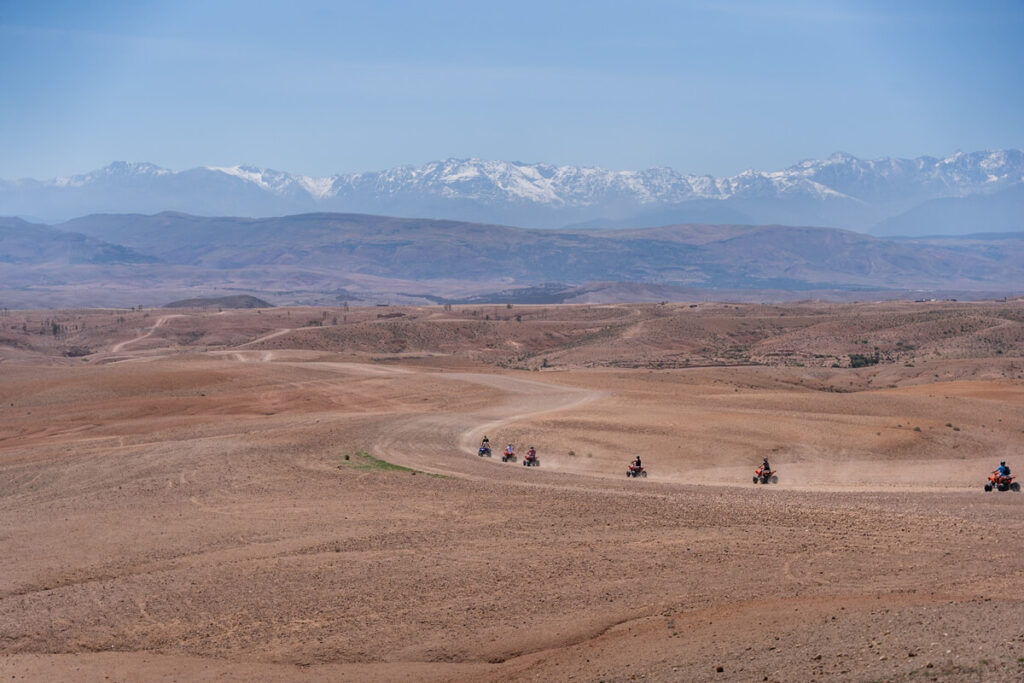
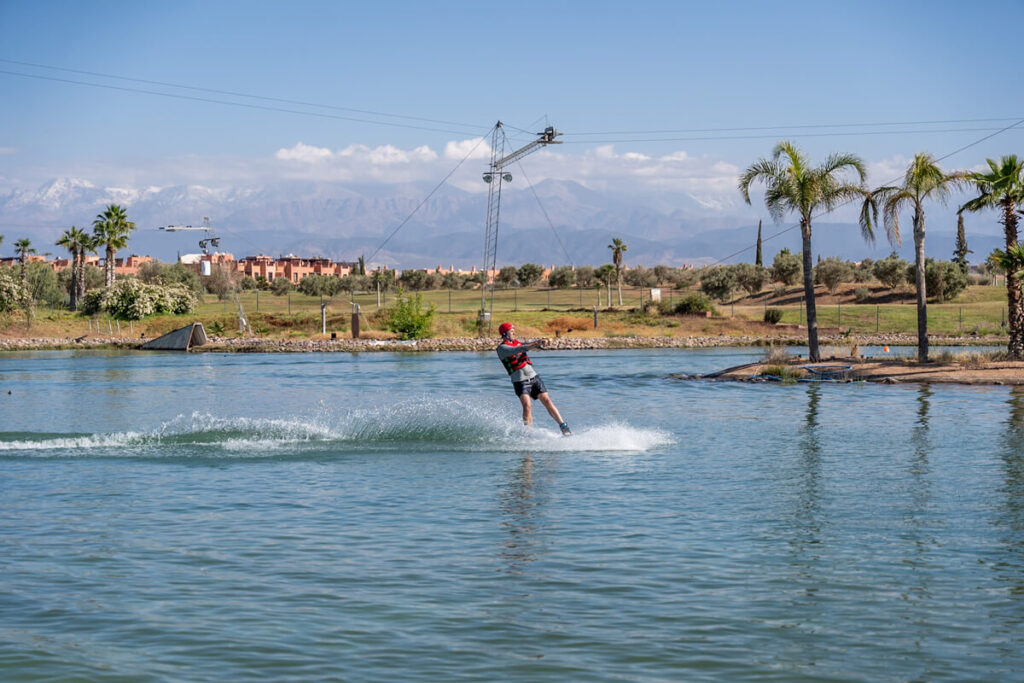
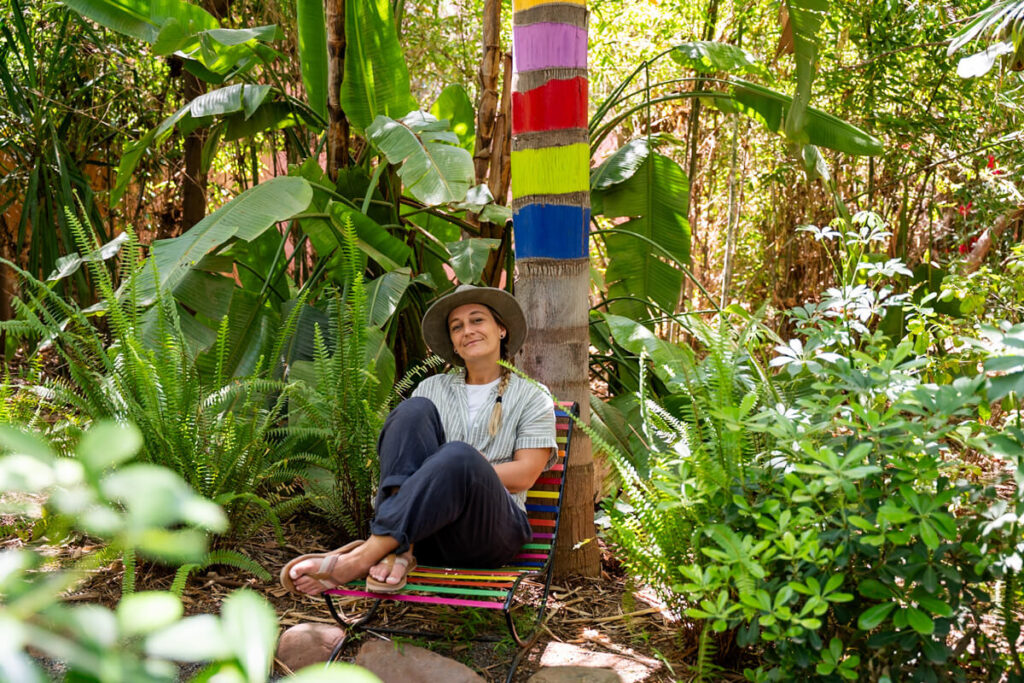
Day 12: Across the High Atlas to Ait Ben Haddou
- Daily distance: 184 kilometers
- Accommodation: Maison d’hôtes Tigminou – Adults Only*
- Highlights: Landscapes in the Atlas Mountains, clay village of Ait Ben Haddou
- Activities: Ouarzazate & Ait Benhaddou Guided day tour from Marrakech*
We finally crossed the High Atlas. The route was not only scenically impressive, but also pleasant to drive. The N9 road is well-developed, has gentle curves and was surprisingly quiet. Google Maps worked reliably here, and the driving time was pretty accurate.
The scenery along the way was spectacular. Rugged mountains, wide valleys, small villages with mud houses, and ever-present magnificent views. A stop at the Tizi n’Tichka Pass at around 2,260 meters is particularly worthwhile. There, you’ll find a beautiful view and a small restaurant with a shop for a short break.
Our tip: Behind the pass, take the exit to Telouet via the P1506. The route is beautiful and leads you directly to Ait Ben Haddou.
Of course, we also visited the famous mud city. This UNESCO World Heritage Site is a real highlight in Morocco. Not only because of the many film sets, but also because it’s simply impressive to walk up through the old alleys. From up there, you have a fantastic view of the oasis valley and the surrounding area.
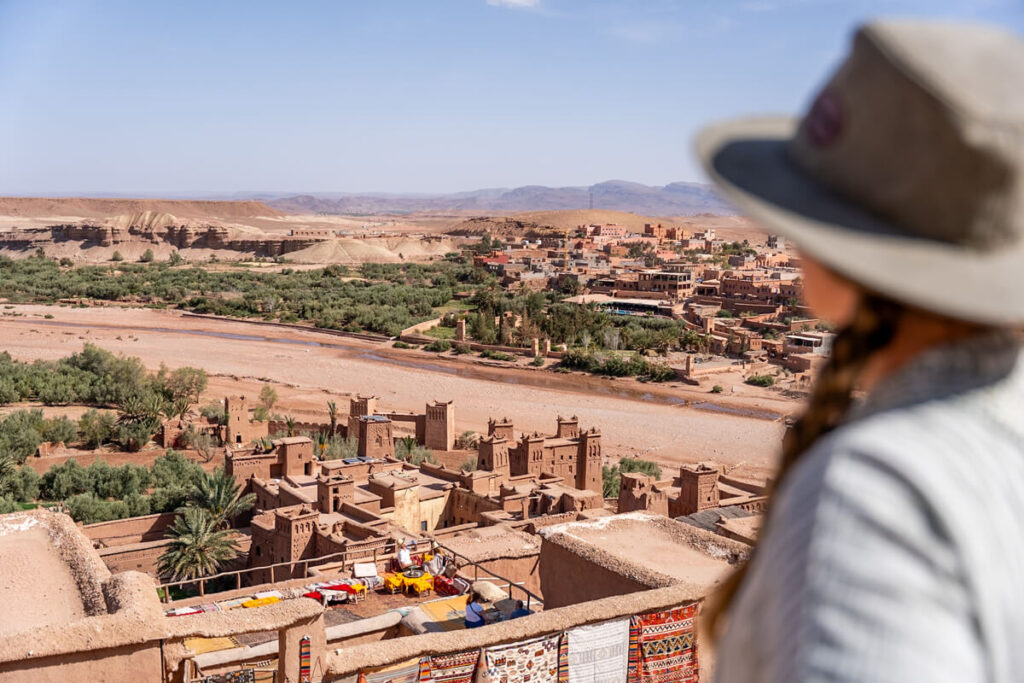
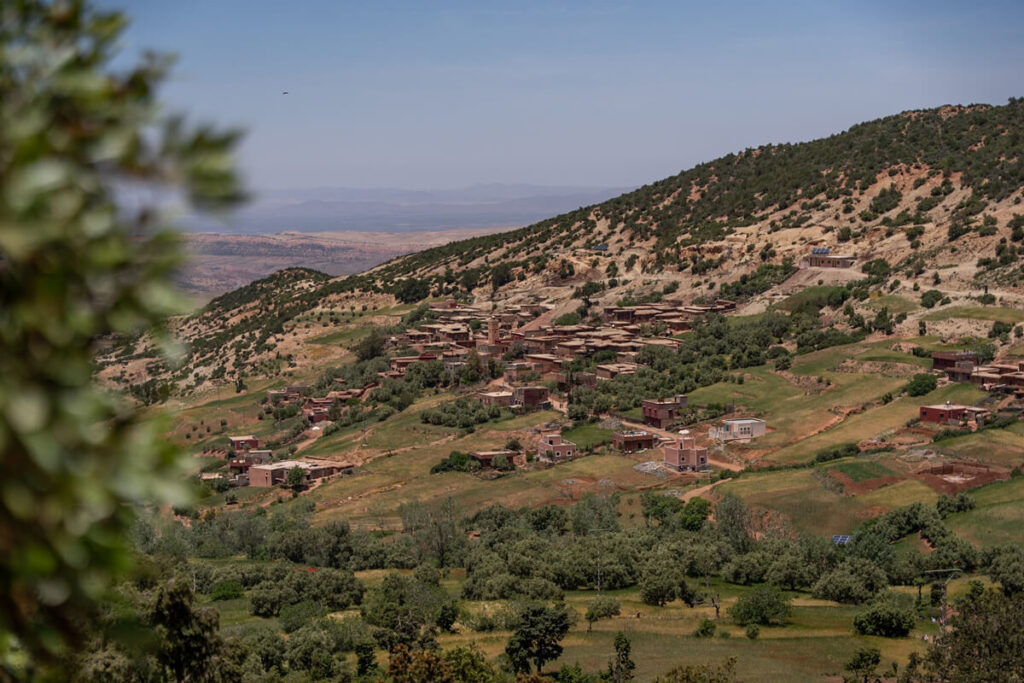
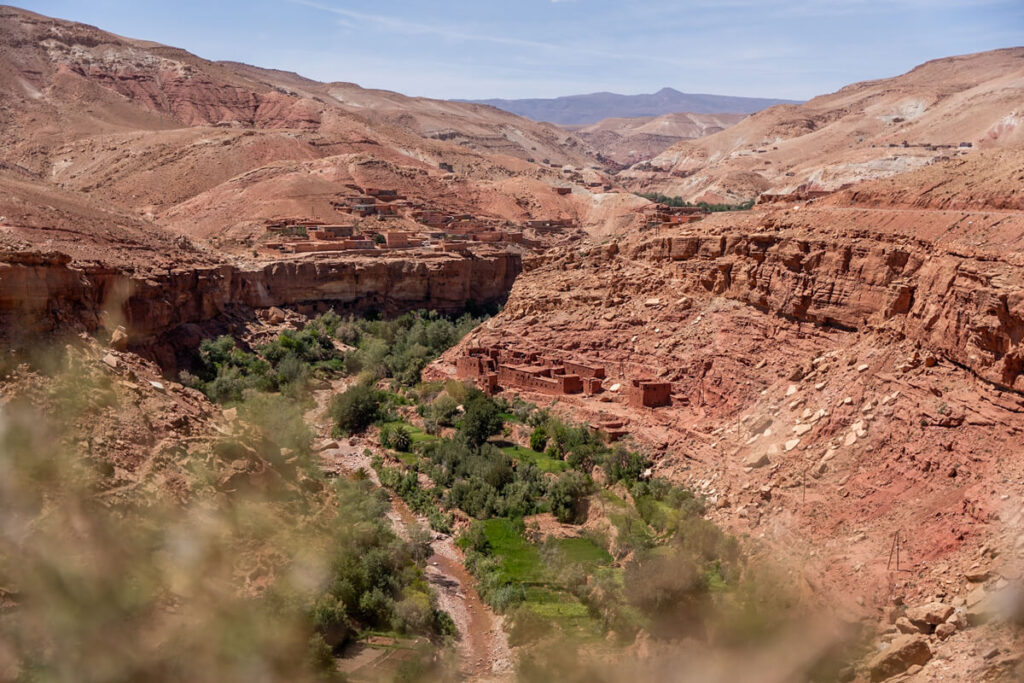
Day 13: Kasbah Road
- Daily distance: 193 kilometers
- Accommodation: Riad Dar Bab Todra*
- Highlights: Kasbah Amridil, Dades Valley, accommodation pool
- Activities: 3 days 2 nights Merzouga desert camp from Marrakech*
On the 13th day of our round trip through Morocco, we continued east – along the famous Kasbah Road from Ouarzazate to Tinghir. The route leads through an impressive landscape with palm groves, rugged mountains, and, time and again, these typical mud fortresses, which seem like they come from another time.
A stop you should not miss: the Kasbah Amridil in the Rose Valley near Skoura. It is one of the best-preserved kasbahs in Morocco – and offers a great insighthow people used to live here. You can explore it on your own or with a guide (entrance fee: 2 x 40 dirhams for both parts of the kasbah).
Then we continued through the fertile Dadès Valley. Along the way, we passed many small villages, green palm oases, and beautiful viewpoints. In the late afternoon, we arrived at the Riad Dar Bab Todra*, just outside of Tinghir. The rest of the day was spent relaxing. Pool, view, and just doing nothing.
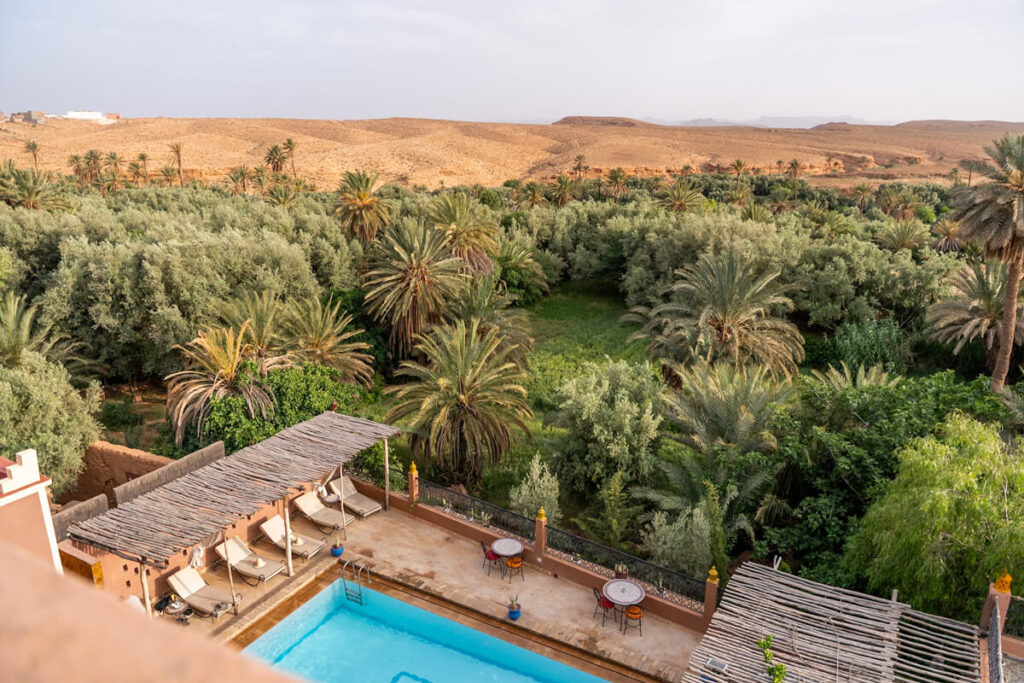
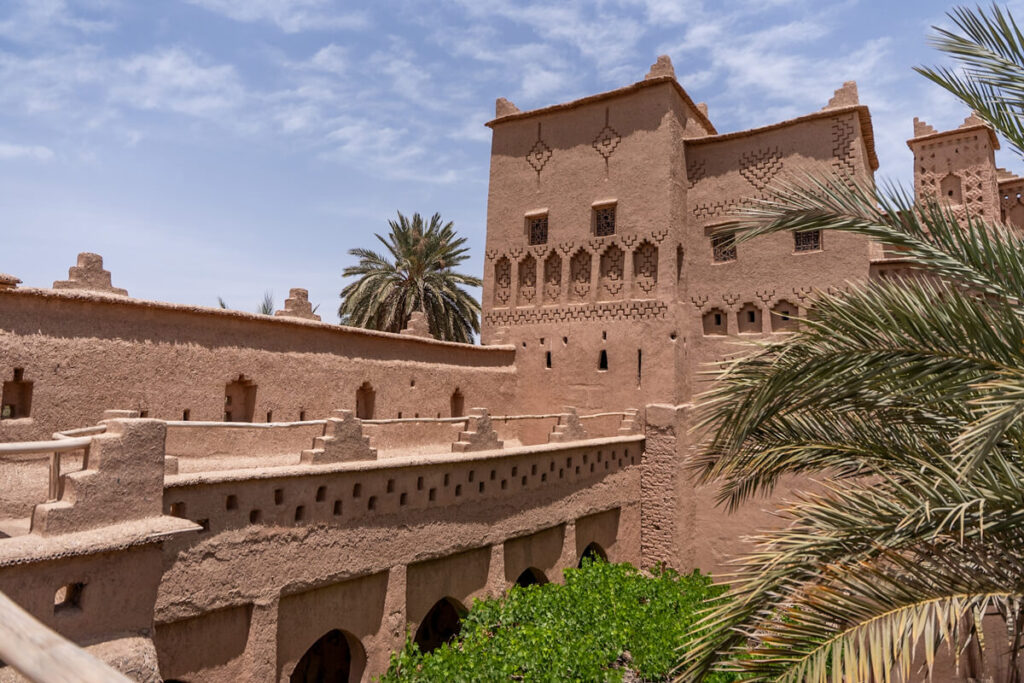
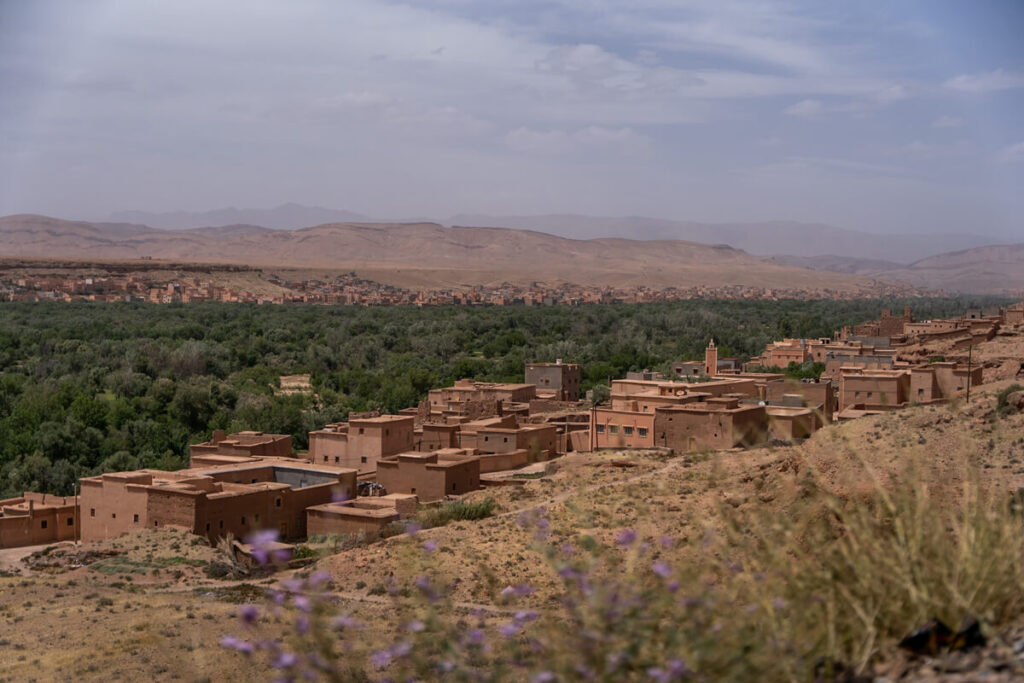
Day 14: Todra Gorge and Merzouga
- Daily distance: 189 kilometers
- Accommodation: Kanz Erremal*
- Highlights: Todra Gorge, barren landscapes, and the Erg Chebbie Desert
- Activities: Overnight stay in a luxurious desert tent with dinner*
After breakfast, around 9:00 a.m., we headed straight to the Todra Gorge. The light is particularly beautiful in the morning, and it is still pleasantly quiet. The high rock walls are truly impressive, especially where they almost touch. We walked the entire way through, enjoyed the scenery, and took a few photos.
Afterward, one of the longer stages of our tour awaited: the journey into the desert, to Merzouga. The landscape became more barren with every kilometer, and eventually the first sand dunes appeared on the horizon. This moment is always special.
Our accommodation was the Kanz Erremal*, which had a beautiful pool and a direct view of the dunes. In the afternoon, we simply relaxed, enjoyed the sun, and later took a walk into the dunes to experience the sunset. A perfect day for us on the edge of the Sahara.
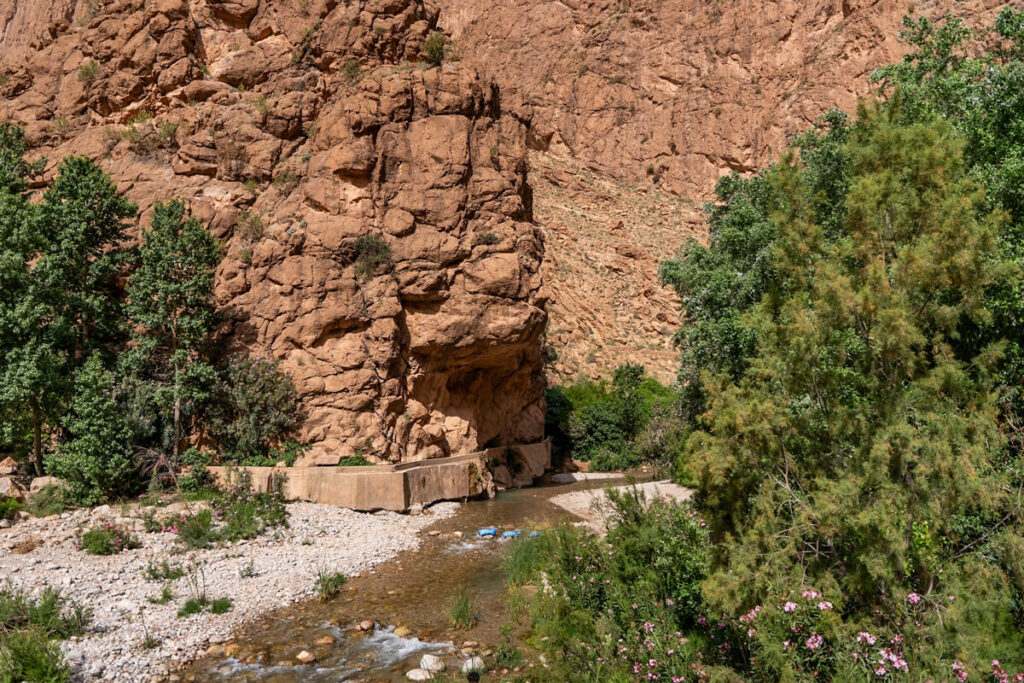
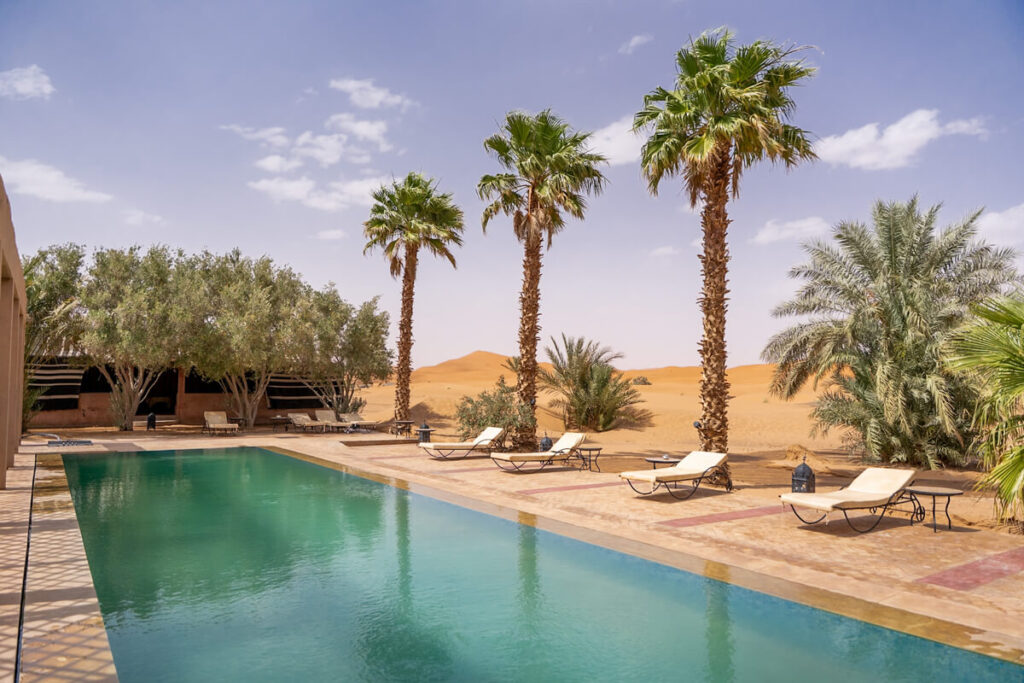
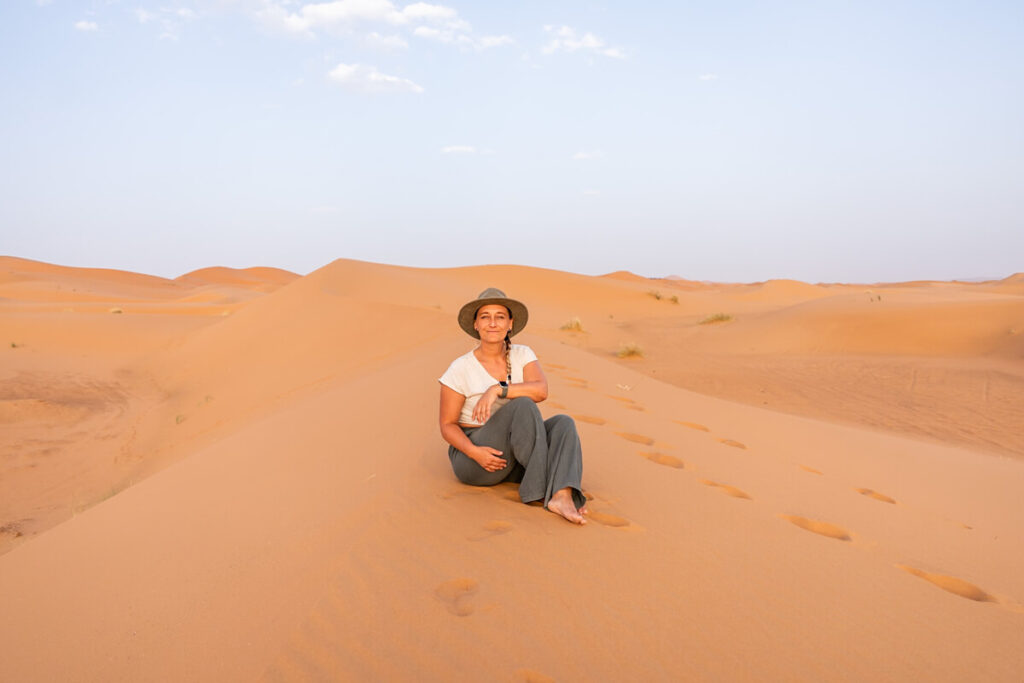
Day 15: Merzouga and Drâa Valley
- Daily distance: 281 kilometers
- Accommodation: Kasbah Hnini*
- Highlights: Buffy tour through the desert, Drâa Valley, Kasbah Hnini
- Activities: Adventure quad bike safari and sandboarding*
We started super early. Our buggy tour through the dunes of Merzouga began at 6:00 a.m. Unfortunately, the sky was cloudy, so we didn’t get a classic sunrise, but the ride was still really cool and a lot of fun. You can also book such tours spontaneously on-site. Prices range from around 100 euros per hour.
Back at the hotel, we enjoyed a hearty breakfast before setting off again. This time, we headed to the Drâa Valley. Our destination was the Kasbah Hnini*, a true gem in the middle of the oasis. The complex has been lovingly restored, with many beautiful details. And the entire setting is simply unbelievably beautiful.
We spent the afternoon relaxing in the hotel and in the evening, we took a stroll through the palm grove. Absolute peace, birdsong, and this special landscape in the middle of the rocky desert. A moment like that when you just think: How beautiful can it really be?

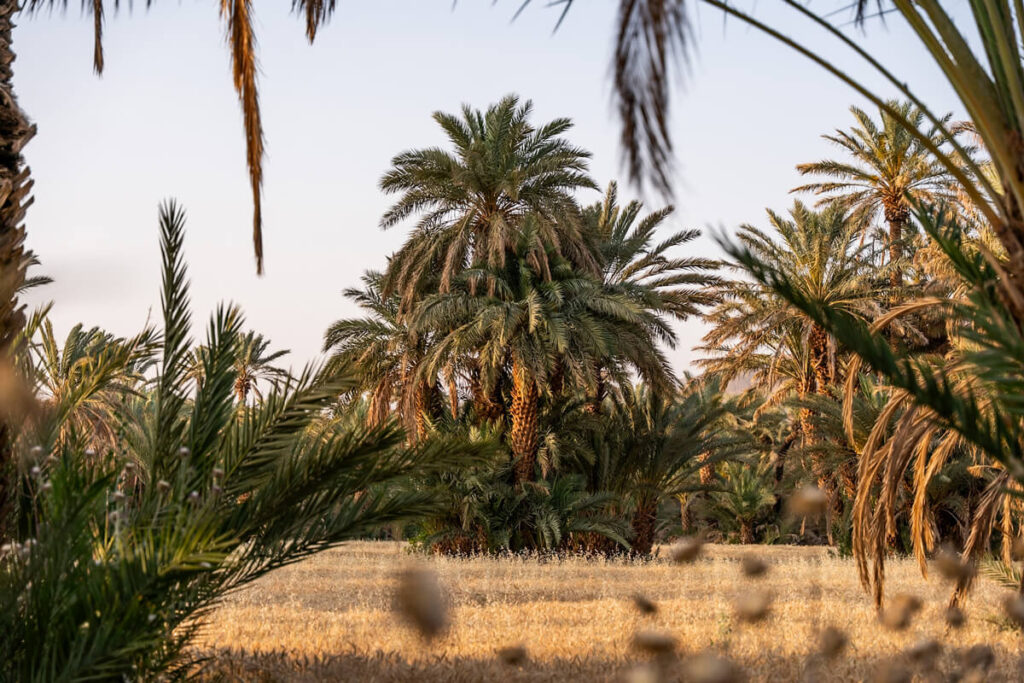
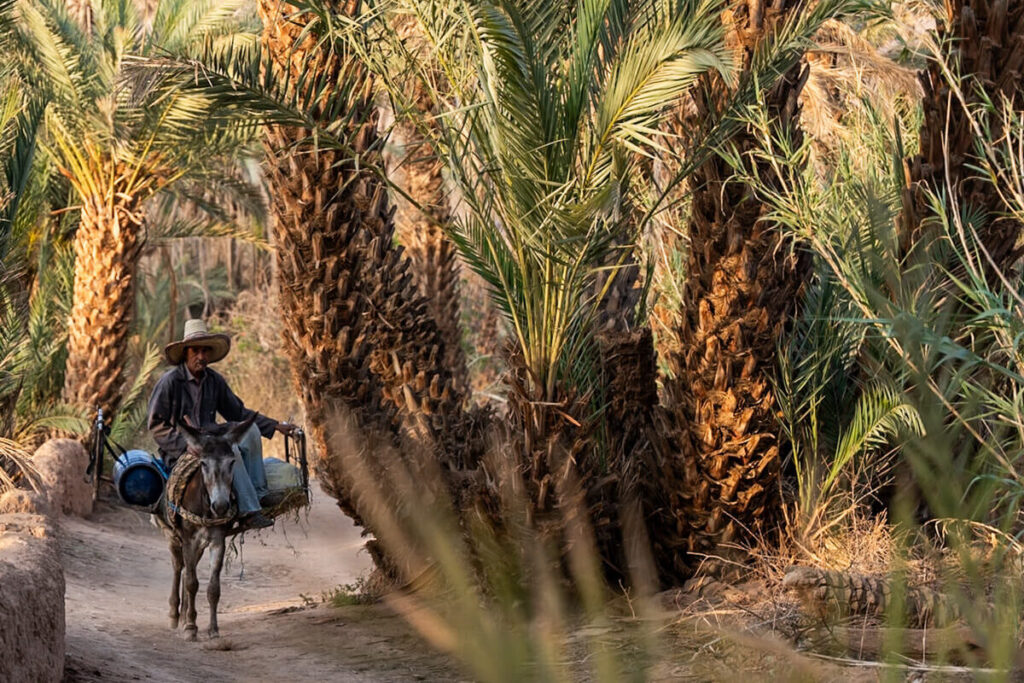
Day 16: Drive to Taghazout & Beach Hotel
- Daily distance: 422 kilometers
- Accommodation: Hyatt Regency Taghazout*
- Highlights: Landscapes along the way, the top beach hotel
- Activities: Taghazout Beach surf course with lunch and transfer*
Now a really long day of driving lay ahead. Over 422 kilometers across the country, from the desert to the Atlantic coast. The route was long, more than six hours, but the scenery was very beautiful. At times, it looked as if we were on another planet. Barren stone deserts, bare hills, almost like the moon.
In the late afternoon, we arrived at the Hyatt Regency Taghazout*. A real highlight for unwinding. The location is quiet and right by the sea; the hotel is stylish, relaxed, and has a huge infinity pool overlooking the water. There’s also a cool beach bar, good restaurants, a gym, and a spa area.
We simply lay by the pool, enjoyed the sun, and in the evening, treated ourselves to a dinner overlooking the Atlantic. As the sun set, the long day of travel was almost forgotten. We would have loved to extend our stay by two weeks.
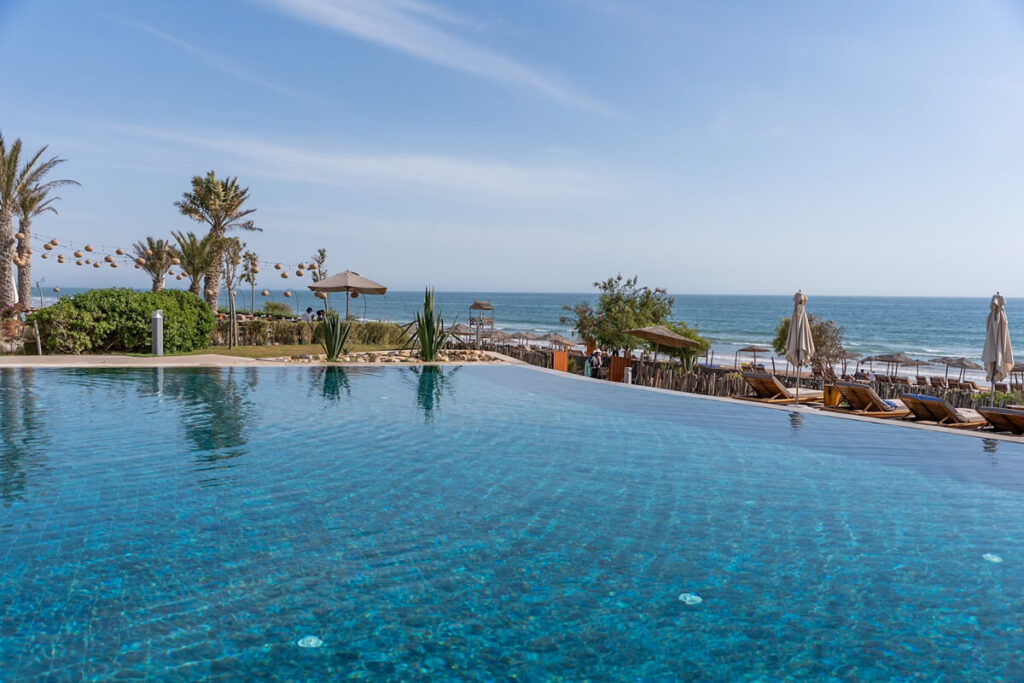
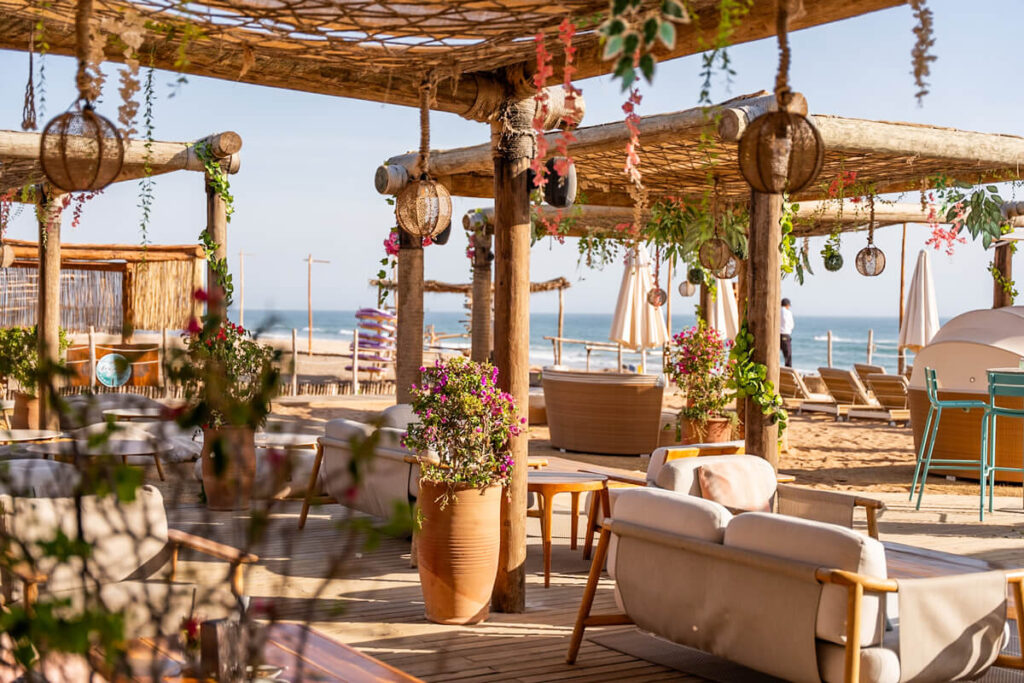
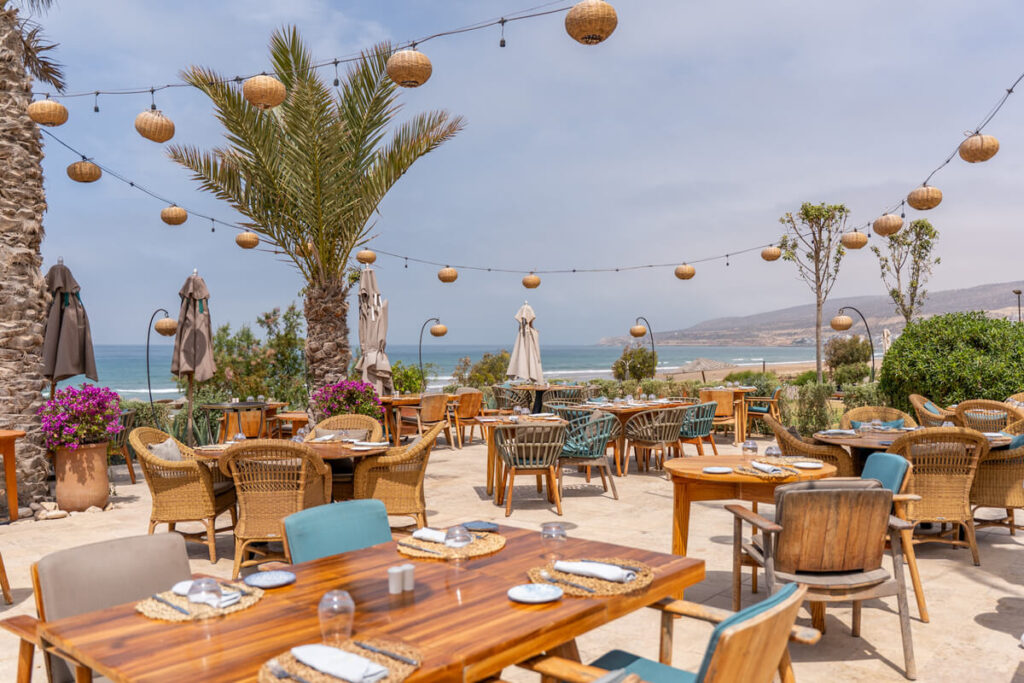
Day 17: Exploring Taghazout
- Daily distance: 20,000 steps
- Accommodation: Hyatt Regency Taghazout*
- Highlights: Beach promenade, Taghazout, paddle tennis
- Activities: Excursion to Paradise Valley*, sandboarding in the dunes*
We started the day very relaxed. In the morning, we simply enjoyed the hotel to the fullest. The breakfast was really good, it had everything you could wish for, and with that view of the sea. You can hardly start the day better, right?
In the afternoon, we took a leisurely stroll along the beach promenade to Taghazout. The walk takes about 20 minutes and leads directly along the water. The small surfer village has a unique vibe. Relaxed cafes, colorful shops, and barefoot people with surfboards everywhere.
The place is perfect if you want to try surfing*. There are countless surf schools and rental shops. We had a delicious meal there in the evening and then returned to the hotel. To round off the day, we enjoyed a round of paddle tennis and a glass of wine on our terrace.
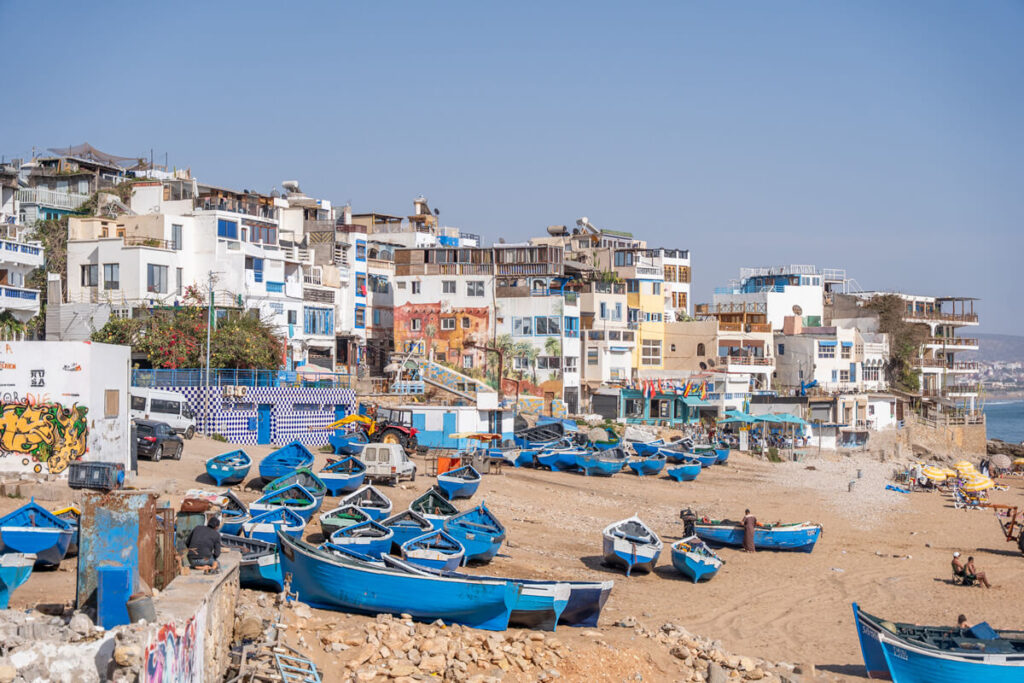
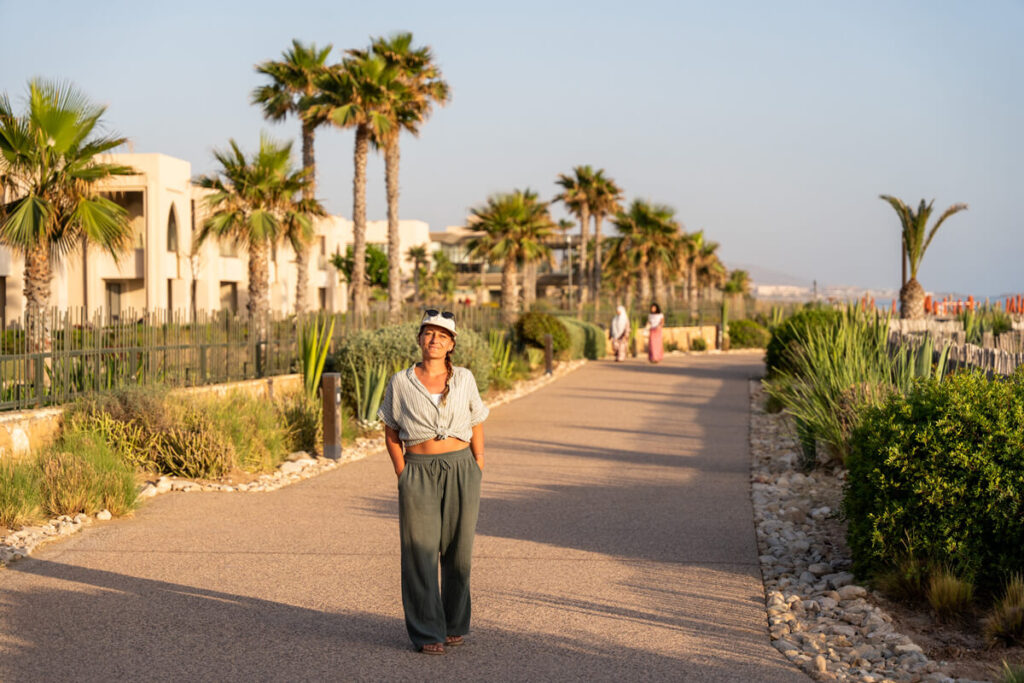

Day 18: Port City of Essaouira
- Daily Distance: 166 kilometers
- Accommodation: Riad Lyon Mogador*
- Highlights: Tamri Beach, Tamri Dunes, Essaouira
- Activities: Historical & cultural sightseeing tour of Essaouira*
Now it was time to say goodbye to the beautiful Hyatt in Taghazout. With a bit of a heavy heart, the journey continued along the Atlantic coast towards Essaouira. The journey was truly worth it. Along the way, there were great viewpoints, expansive views of the sea, and even a few impressive sand dunes right next to the road.
Once we arrived in Essaouira, we checked into our riad and immediately set out to explore the city. Naturally, we enjoyed all the typical highlights: the medina, the harbor, the city walls, and the many small alleys with shops and lovely cafés. And, of course, we also gave a little love to countless cats.
We love Essaouira! The city has a very special atmosphere. Quiet, charming, and super relaxed. You can hear seagulls screeching everywhere, which is probably due to the fresh fish that arrives at the harbor every day. A perfect mix of maritime flair and oriental old town charm.
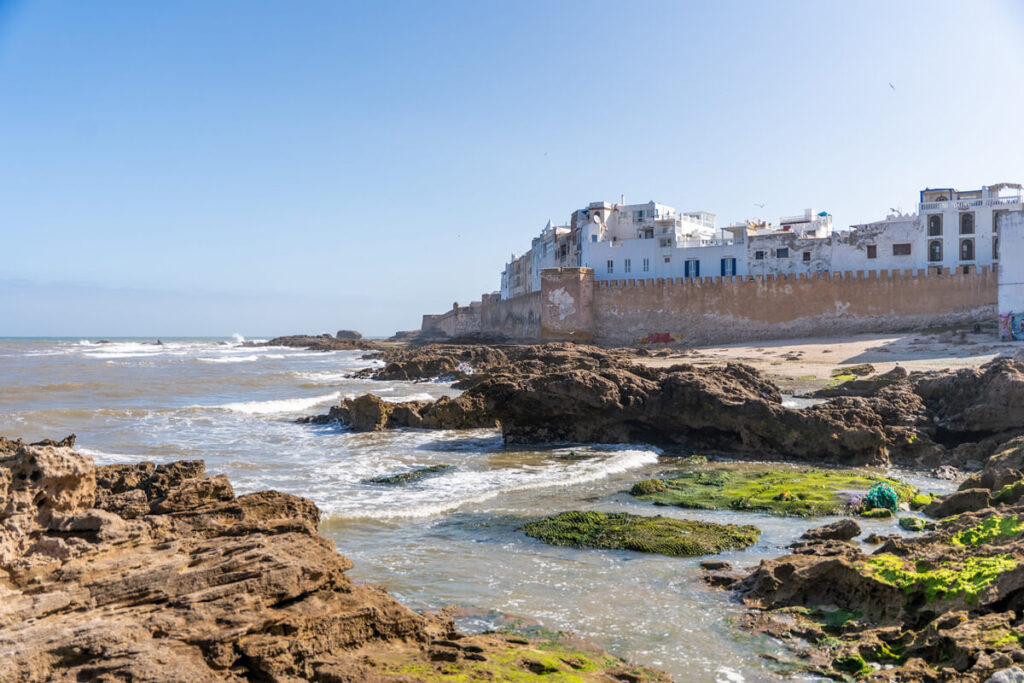

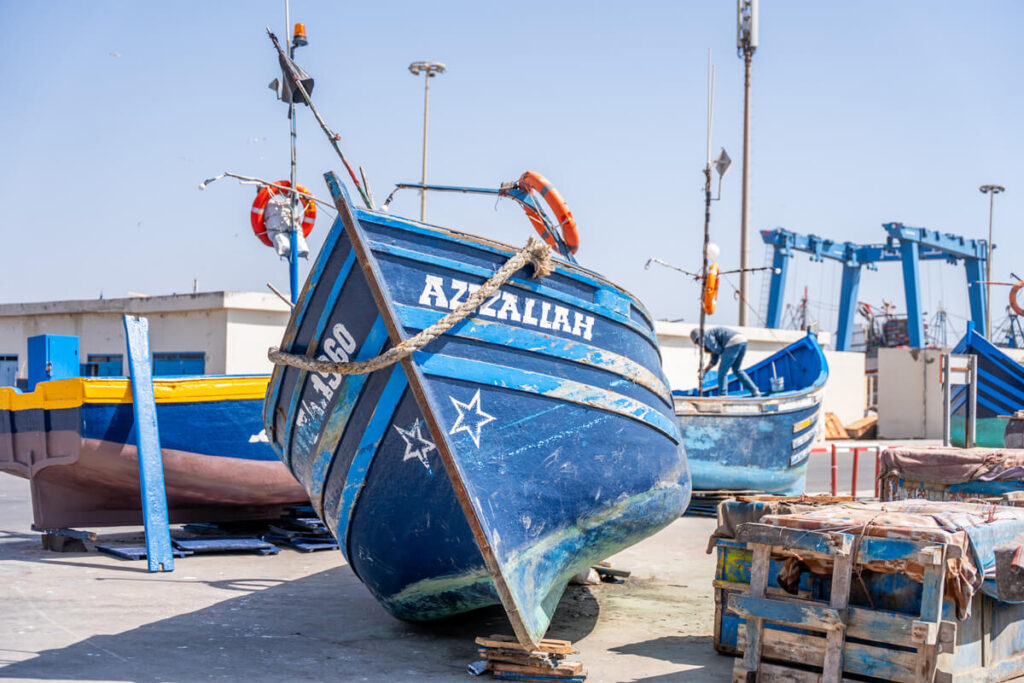
Day 19: Last Walk & Return Flight
In the morning, we took one last walk through the medina of Essaouira. We strolled through the quiet alleys, bought a few souvenirs, and soaked up the special atmosphere. Around 10:30, we returned to Marrakech, where we dropped off the rental car at the airport.
Our trip ended there. Our suitcase was full of experiences, impressions, and quite a lot of sand. In almost 3,000 kilometers, we experienced Morocco intensely. Mountains, desert, coast – this time, we really had everything. Morocco surprised us again. So diverse, rugged, welcoming, colorful, and sometimes a bit chaotic. And that’s precisely what makes it so appealing.
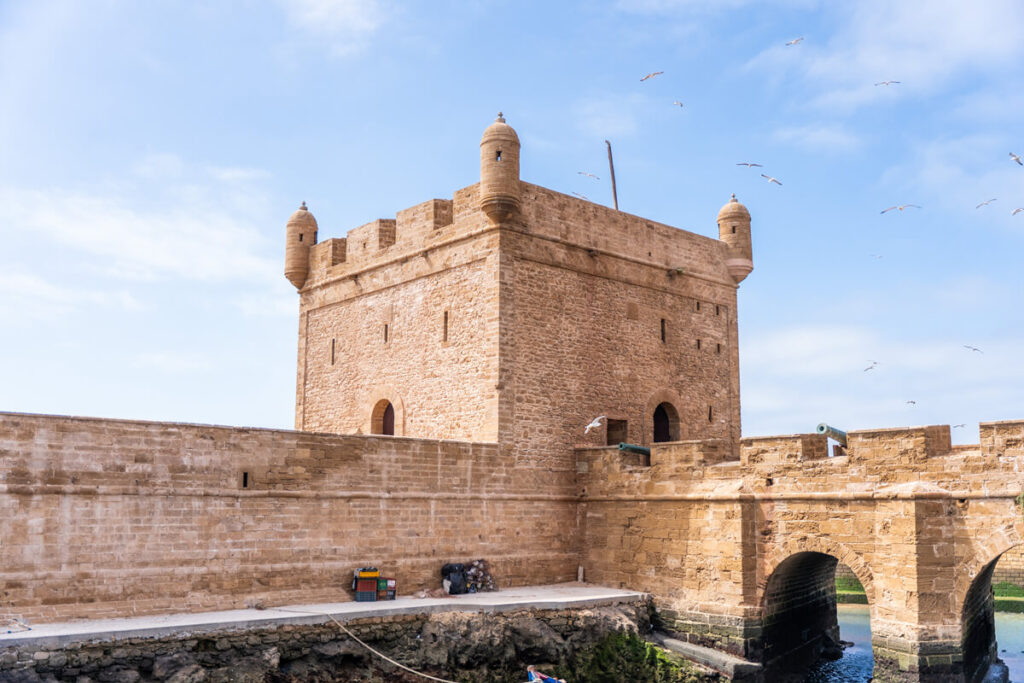
Our best travel tips for Morocco
Arriving by plane
You can easily reach Morocco from many German cities. There are direct flights to Marrakech, Fez, Agadir, or Casablanca, for example. For a round trip, multi-leg flights are also worthwhile, e.g., Marrakech – Fez or Agadir – Marrakech, depending on whether you’re planning a trip to the desert or the coast.
The flight time is usually about 4 hours. Airlines operating flights include Lufthansa, Eurowings, Ryanair, easyJet, Transavia, Royal Air Maroc, and sometimes Condor, depending on the city and season. Book your flight to Morocco here*.
Entry into Morocco
As a German citizen, you do not need a visa if you stay for up to 90 days. Your passport must be valid for at least 6 months upon entry. You can find all the detailed information here: Everything about entering Morocco.
When is the best time to travel to Morocco?
It depends on what you want to do:
- Spring (March–May): Perfect for tours, mild climate, blooming landscapes.
- Autumn (Oct–Nov): Also great, less hot, especially for the desert.
- Summer (July/August): Hot, especially inland. The coast is fine, the south is sometimes extreme.
- Winter (Dec–Feb): Good time for the south and coast. It can snow in the mountains.
We were last in Morocco in May and experienced very different temperatures depending on the region. By the sea, for example in Taghazout, and in the northern cities like Chefchaouen and Fez, it was pleasantly warm at 22–25°C, ideal for sightseeing.
It only got really hot beyond the Atlas Mountains. There we had average temperatures of around 30°C during the day, and in the desert near Merzouga it even reached up to 38°C. In Essaouira, you always have to expect cooler temperatures (18–20°C) and wind. It was only there that we first took the sweaters out of our suitcases.
Is Morocco a safe travel destination?
Generally: Yes – with a healthy dose of caution. In tourist cities like Marrakech or Fez, you should beware of pickpockets. Traveling alone as a woman? It’s better to dress more conservatively. We always felt safe on our tour, even in small towns or remote regions.
In Fez and Marrakech, you’ll often be approached and told that a tourist attraction is closed or that you’re on the wrong path, before directing you to a shop or a tour. The best thing to do is just keep going, smile, and don’t let yourself be put off.
Which accommodations can you recommend?
Morocco offers a huge selection of accommodations. From charming riads in the medina to chic seaside resorts to simple guesthouses in the countryside, there’s everything. The riads, in particular, have a lot of charm and atmosphere. They are often lovingly restored old town houses with a courtyard, roof terrace, and Moroccan flair.
‼️ Important to know: Many riads are thinly soundproofed and not wheelchair accessible. There are narrow staircases, no elevators, and some rooms are located directly on the street or next to a mosque. If that bothers you, a hotel outside the medina might be a better choice.
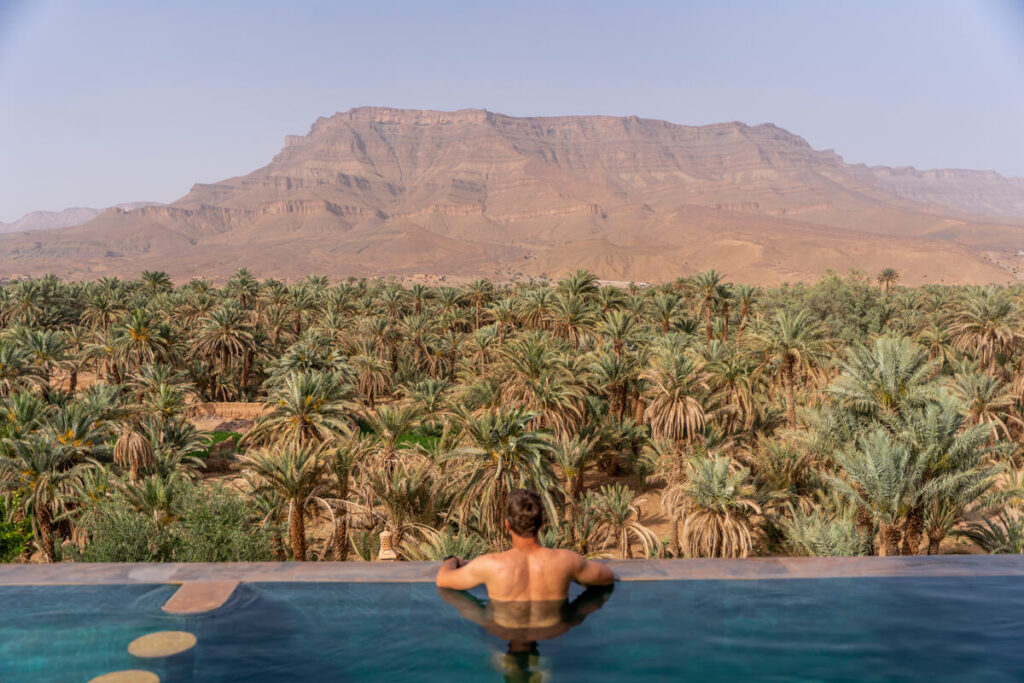
Where is the best place to book a rental car for Morocco?
It’s best to book online in advance via billiger-mietwagen.de* – you can often get very good deals there with fully comprehensive insurance with no excess, which is really worth it. Pay attention to fair fuel policy (“full/full”) and good reviews from the rental companies. We recommend AutoEurope, Argus Car Hire, Sunny Cars, or SIXT.
Pick-ups at the airport or in the city are easy. But be careful: The traffic in Marrakech and other big cities is really wild. We’d rather leave the car there and walk or take a taxi.
Our tip: Keep an eye on the prices even after booking! We got our rental car for €220 (18 days) because we canceled twice and rebooked at a lower price. From the original price of €299, it went down to €265 and then to €220. This is super easy if you can cancel for free.
Morocco Tour: How safe is driving?
With a little driving experience, it’s absolutely doable. Roads are often well-maintained, but you should:
- Drive carefully – especially in villages because of animals and ambulances. People
- Always use their indicators and honk, better too much than too little
- Avoid driving in the dark – there are lots of unlit vehicles and donkey carts
- Use toll roads, they are usually emptier and in top condition
- Observe the speed limits – there are lots of police and radar controls!
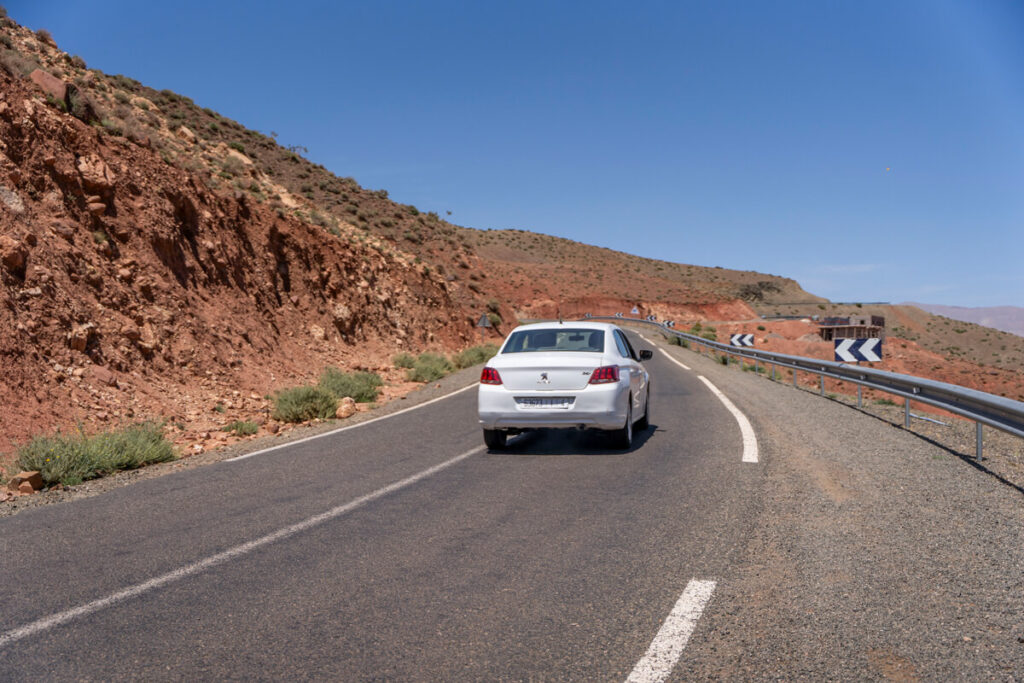
How much does a round trip like this cost?
We were on the road for three weeks and spent around €4,400 for the two of us. That’s about €116 per day per person for accommodation, rental car, food, entrance fees, etc. Of course, you can get cheaper or even more luxurious options. You can find a detailed cost breakdown here: This is how much our tour through Morocco cost.
Internet in Morocco
We had the eSIM from Airalo* (network: Orange) with unlimited data volume. Overall, it worked really well. The network was only a bit slower in a few cities, but otherwise stable everywhere. And: Wi-Fi is available in almost every accommodation, so no stress.
Alternatively, you can easily get a local SIM card, for example from Maroc Telecom, Orange, or Inwi. You can find them directly at the airport or in small shops in the cities.
Packing list – What shouldn’t I forget?
We traveled with hand luggage and a backpack in Morocco. In the suitcase: mostly summer clothes (shorts, skirts, linen trousers, shirts, blouses and tops). But also a pair of socks and a sweater for cooler evenings should not be missing. A jacket? We didn’t need it.
The most important things are comfortable shoes for exploring the cities, a hat for the hot regions and of course bathing suits in case you want to jump into the pool or the Atlantic.
Other things we had with us:
- Power strip* + USB hub*
- You do NOT need an adapter (sockets like in Germany)
- Camera, memory cards & Hard drive for data backup
- Travel pillow* (very important!)
- Sunscreen (better to bring from home – it’s cheaper!)
- Power bank* (for long car journeys and the desert!)
- Offline maps on your phone (e.g., maps.me or Google Maps offline)
- E-SIM* or local SIM card (e.g., Maroc Telecom)
- Sunglasses and a sun hat
- Small jute bag for shopping
- Water bottle* (refillable, saves plastic)
Which travel guide do you recommend?
As always, the travel guide from DuMont Verlag* was super helpful for planning my trip and getting a bit of inspiration beforehand. On over 400 pages you’ll find tons of information about the country, its people, and its sights. We absolutely love browsing through books like these before our trip, highlighting a few tips, and immediately feeling even more excited to set off.
The Lonely Planet* travel guide is also highly recommended, especially if you’re traveling independently and enjoy exploring on your own. It contains detailed information on sights, accommodations, restaurants, and many practical travel tips. Particularly helpful: There are ready-made route suggestions and a removable fold-out map for on the go.